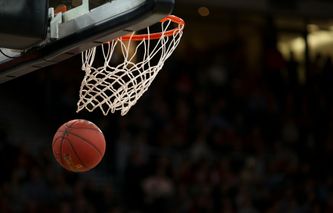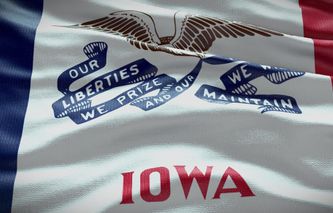 |
| |
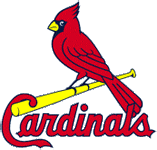 Logo 1998-Present |  Alternate Logo 1998-Present |  |
100 S. 4th Street St. Louis, MO 63102 | http://www.stlcardinals.com | |
HISTORICAL MOMENTS:
1892 | With the folding of the American Association, the St. Louis Brown Stockings are among the four teams that are accepted into the National League. In their first season in the NL, the Brown Stockings struggle to finish with a 56-94 total record in a split season. One matter of note, they hosted the first Sunday game on April 17th, losing to the Cincinnati Reds 5-1. |
1893 | In their second season, the Brown Stockings settle on just one manager but continue to struggle to finish in 10th place with a 57-75 record. |
1894 | The Brown Stockings continue to struggle to finish in ninth place with a terrible record of 56-76. |
1895 | The Brown Stockings continue to struggle as they go through four managers on the way to finishing in 11th place with an awful 39-92 record. |
1896 | The Brown Stockings struggles continue as they finish in 11th place with an awful record of 40-90. |
1897 | The Brow Stockings suffer an embarrassing season with a 23-102 record, the team would not only finish in last place but more than 20 games worse than the 11th place Louisville Colonels. |
1898 | Owner Chris Von der Ahe and his corporation declare bankruptcy, as the Brown Stockings struggle again this time with a 39-111 record. |
1899 | With the National League planning on cutting down to eight teams following the season, the team from St. Louis is one of the candidates to be bounced, that is until Frank and Stanley Robison, who ran a moderately successful team in the Cleveland Spiders decided to step in and take over team the team. The Robisons took many of their stars, including Cy Young from Cleveland, with them letting the Spiders rot to a worst-ever 20-134 record, before folding. The Robisons would also change the St. Louis team’s name to Perfectos. The Perfectos would show immense improvement, finishing in fifth place with a record of 84-67. They also changed the team’s color to red. Sportswriter Willie McHale, of the “St. Louis Republic”, heard a lady remark, “What a lovely shade of cardinal,” The new nickname was used in his column, and struck a chord with St. Louis fans, as the team adopted it as the official nickname the following season. |
1900 | The Cardinals begin the 20th Century on a disappointing note falling to fifth place with a record of 65-75. |
1901 | The Cardinals rebound off a disappointing season to post their second winning season in as many years with a 76-64 record good enough for fourth place. |
1902 | The Cardinals get company in St. Louis when the American League relocates a team to the gateway city. The team would even take the discarded name of the Browns. |
1903 | The Cards stumble to a last-place finish with a woeful 43-94 record. |
1904 | The Cardinals would struggle to finish in fifth place with a record of 75-79. |
1905 | The Cardinals’ struggles continue as they finish in sixth place with a dreadful 58-96 record. |
1906 | The Cardinals have another dreadful season as they narrowly avoid 100 losses by finishing in seventh place with a record of 52-98. |
1907 | The Cardinals continue to struggle to fall into last place with a miserable record of 52-101 record. |
1908 | The Cardinals long a National League whipping boy finish in last again with a 49-105 record, though the team would not improve for a few more years it would be the final 100-loss season for the Cardinals in the 20th Century. |
1909 | The Cardinals narrowly avoid their third straight 100-loss season, placing seventh with a terrible 54-98 record. |
1910 | The Cardinals’ struggles continue as they finish in seventh place with a miserable 63-90 record. |
1911 | After nine straight losing seasons, the Cardinals finally post a winning record, finishing in fifth place with a record of 75-74. |
1912 | The Cardinals plunge back into sixth place, posting a disappointing record of 63-99. |
1913 | The ownership of the club passed to Robison’s daughter, Helene Hathaway Britton. Mrs. Britton bought out Manager Roger Bresnahan’s contract and hired Miller Huggins. However, in Huggins’ first season, the Cards do not fair any better finish dead last with a 51-99 record. |
1914 | In Miller Huggins’ second year, the Cardinals finished the season in third place with an 81-72 record. It was something of a sensation because it was the best season for the franchise since joining the National League. |
1915 | The Cardinals are not able to build off their third-place finish and fall back to sixth place with a 72-81 record. |
1916 | After another terrible 60-93 season, the Cardinals are sold by Helene Hathaway Britton to her attorney, James C. Jones, and stockholders, including a St. Louis automobile dealer named Sam Breadon. |
1917 | The fan-controlled club needed a baseball man to run it. They found one in Branch Rickey, then business manager of the American League St. Louis Browns. Rickey was named president; however, the club continued to struggle financially. However, the Cards show some promise placing third with a solid 82-70 record. |
1918 | With the departure of Manage Miller Huggins to the New York Yankees, the Cardinals fall back into last place with a 54-83 record. |
1919 | The Cardinals’ struggles continue as they finish in sixth place with a woeful record of 54-83. |
1920 | Sam Breadon became president and majority stockholder of the Cardinals, and Branch Rickey moved to Vice President and General Manager. One of Breadon’s first moves was to sell Robison Field and become tenants at Sportsman’s Park. Branch Rickey would use proceeds from the sale of the ballpark to invest in the first Cardinals farm club affiliation at Houston, TX, a move that would single a new strategy in running the franchise. |
1921 | The Cardinals put together their finest season to date, placing third with a solid 87-66 record, coming within seven games of first place. |
1922 | Rogers Hornsby wins the Triple Crown with 42 home runs, 152 RBI and a .401 average, as the Cards finish in third Place again with a solid 85-69 record. |
1923 | The Cardinals take a step backward, finishing in fifth place with a disappointing record of 79-74. |
1924 | Rogers Hornsby wins the batting title with a .424 average, the highest mark in the National League during the 20th century. However, the Cards would struggle to finish in sixth place with a disappointing 65-89 record. |
1925 | Rogers Hornsby wins his second Triple Crown in four years with 39 home runs, 143 RBI and a .403 average. On Memorial Day, Hornsby was named manager of the club, succeeding Branch Rickey, who became strictly a front-office man. The Cards would go on to finish with a 77-76 record only good enough for fourth place. Rickey had begun building a reputation for an excellent eye for raw talent and thrifty dealings. The Cardinals had six farm teams in 1925, and that number increased over the next few years to help fuel their growing success story. |
1926 | Led by NL MVP Bob O’Farrell, the Cardinals win their first-ever National League Pennant with an 89-65 record edging out the Cincinnati Reds by two games. The team led the NL in eight offensive categories. Their 90 home runs led the league, while their 82 triples placed them second. They were not caught stealing once (83 SB). In their first World Series appearance, the Cardinals faced the New York Yankees. After taking a 2-1 series lead behind the stellar pitching of Jessie Haines. However, the Yanks would bounce back to take the next two games in Sportsmen’s Park behind the bat of Babe Ruth, who belted three homers in Game 4. The Cardinals were faced with a do or die situation heading back to the Bronx for Game 6. With their backs to the wall, the Cards sent Grover Cleveland Alexander out to the mound, and he came trough retiring the last 21 Yankees in a 10-2 victory. Alexander was then called upon again in Game 7 to protect a 3-2 lead in the seventh inning with bases loaded. Alexander would strike out Tony Lazzeri to end the 7th, and after retiring the Yanks in order in the eighth. After setting down the first two Yanks in the ninth, Alexander walked Babe Ruth and put the tying run on first. However, Ruth, who had stolen second base in Game 6, tried to steal again. Catcher Bob O’Farrell’s throw to Rogers Hornsby nailed the Yankees’ slugger and ended the fall classic, and gave St. Louis its first World Championship. |
1927 | The Cardinals follow up their Championship with another solid 92-61 season, but fall one and a half games short of a return trip to the World Series. |
1928 | The Cardinals win the pennant with a 95-59 record, behind MVP Jim Bottomley’s 93 extra-base hits and a pitching staff that completed 83 games. However, in a World Series rematch with the New York Yankees, the Cards are swept in four games. |
1929 | The Cardinals suffer through a mediocre 78-74 season and finish in fourth place, 20 games out of first place. |
1930 | On September 28th, the last game of the season, 19-year-old Jay Hanna “Dizzy” Dean made his big league debut, pitching a complete-game three-hitter in a Cardinals win. The Cardinals won the National League pennant a day earlier and finish with a 92-62 record, to narrowly edge out Chicago Cubs by two games. In the World Series, the Red Birds were matched up against the Philadelphia Athletics. After losing the first two games in Philly, the series shifts to St. Louis, where Bill Hallahan pitches a 5-0 shutout. Jesse Haines would follow up with a 3-1 in Game 4 to even the series. However, the A’s would win the next two games to win the World Series in six games. |
1931 | Led by MVP 2B Frankie Frisch, the Cardinals repeat as National League Champions with a 101-53 record. In the World Series, the Cardinals find themselves in a rematch with Philadelphia Athletics. This time it was the Cardinals who took advantage of the first two games at home by getting off to a 2-0 series lead. After the A’s won the next two games in Philadelphia, the Cardinals turned to Bill Hallahan, who shut down the A’s 5-1. However, the A’s would bounce back in Game 6 at Sportsman’s Park to even the series and force a decisive seventh game. In Game 7, the Cards jump out to a 4-0 lead and hold to 4-2 series win thanks to a superb relief outing by Hallahan. The series’ hitting star was Cards Rookie Pepper Martin, who batted .500 with five RBI and five runs scored. |
1932 | The Cardinals followed up their second World Championship with a very disappointing 72-82 season, which saw them finish tied for sixth place. The bright spot of the season was an 18-win season from Dizzy Dean in his first full season in Majors. |
1933 | The Cardinals rebound nicely and finish with an 82-71 record. However, the Cards still land in fifth Place, nine and a half games out of first place. |
1934 | A team dubbed the “Gas House Gang” for their rough style of play wins the National League pennant on the final day of the season with a 95-58 record. Before the season, Dizzy Dean predicted 45 wins between himself and his brother, Paul, a rookie. Dizzy won 30, and the National League MVP, while his brother won 19, for a total of 49. In the World Series, the Cardinals face the Detroit Tigers. The series and was tied three games apiece heading into a decisive Game 7. In the seventh game won by the Cardinals 11-0, a brawl erupted when Joe Medwick slid hard into third base with the game out of reach 9-0. Detroit fans would begin throwing anything and everything at Medwick, which forced Commissioner Kennesaw Landis to order umpires to eject Joe Medwick from the game for his safety and to halt the disturbance. Dizzy Dean won his second series game in that seventh game to equal the effort of his brother Paul. |
1935 | The Cardinals follow up their rough and tumble Championship with another solid 96-58 season. However, they are edged out by four games by the Chicago Cubs for the National League Pennant. |
1936 | The Cardinals are in the thick of the National League Pennant Race again but fall five games short with an 87-67 record. |
1937 | Joe Medwick wins the Triple Crown, and the NL MVP with 31 homers, 154 RBI and a .374 average; it would be the last National League Triple Crown in the 20th Century. The Cardinals only managed to finish in fourth place with an 83-71 record. |
1938 | The Cardinals fall to sixth place struggle all season to post a record of 71-80. |
1939 | After a disappointing season, the Cardinals rebound to a second-place 92-61 season, and miss the National League Pennant by a mere four and a half games. |
1940 | After years of wrangling, the Browns and the Cardinals finally agreed to split the $150,000 cost of installing lights at Sportsman’s Park. The Browns were given the honor of hosting the first night game in St. Louis on May 24th. The Cardinals’ first night game was on June 4th. Joe Medwick went 5-for-5, but the Brooklyn Dodgers trounced the Red Birds 10-1. The Cards would go on to finish in third place with an 84-69 record, as Johnny Mize belted 43 home runs. |
1941 | The Cardinals battle the Brooklyn Dodgers down to the final week of the season, but their 97-56 record leaves them two and a half games short of the National League Pennant. |
1942 | Winning 43 out of their last 51 games, the Cardinals erased a ten and a half-game deficit and passed Brooklyn Dodgers on September 13th on their way to a National League Pennant with a 106-48 record to edge the Dodgers by two games. In the World Series, the Cardinals lost the first game to the New York Yankees 7-3, then roared back to win four straight games. In the fifth game finale at Yankee Stadium,Whitey Kurowski’s ninth-inning home run was the difference as the Cardinals won 4-2 to win the World Series. |
1943 | National League MVP Musial led the league in batting average (.357); hits (220); doubles (48); triples (20); total bases (347); on-base average (.425); and slugging percentage (.562). The Cardinals would go on to win their second straight NL Pennant with a 105-49 record. The Cardinals face the New York Yankees for the second straight season in the Fall Classic, and like the year before losing the opener and win the second game. However, the Yankees would win the next three games in St. Louis to take the series in five games. |
1944 | Led by Short Stop Marty Marion, who wins the National League MVP, the Cards win their third straight National League Championship with a 105-49 record. The Cardinals World Series opponent would be their Sportsmen’s Park landlord St. Louis Browns, who won their first and only American League Pennant. The series was dubbed the “Streetcar Series” because of the mode of travel used to get to games. The Browns would take two of the first three games. Stellar pitching by Harry Brecheen, turned the series around after Brecheen’s Game 4 performance Mort Cooper helped the Cards take a series lead, which set them up for the kill in Game 6, as Cardinals win their second World Series in three years. The two teams combined to strike out six-game Series-record 92 batters, 49 by Cardinal pitchers and 43 by Browns’ hurlers. |
1945 | The Cardinals’ quest for a fourth straight National League Pennant falls three games short as the Chicago Cubs beat out the Cards who finish with another solid 95-59 record. |
1946 | The Cardinals and Brooklyn Dodgers finished the regular season in a tie for first in the National League with a 96-58 record, the first time that occurred in the major leagues. The Cardinals would take the first two games of a three-game series with the Dodgers to decide the National League Championship. The Cardinals would go on to take on the Boston Red Sox in a classic seven-game World Series. With the score tied at three in the eighth inning of Game 7, Enos Slaughter singled, then scored from first on Harry Walker’s double to short left-center. Slaughter’s “Mad Dash” surprised Red Sox relay man Johnny Pesky, whose momentary hesitation allowed Slaughter to score the winning run. Harry Brecheen, who was the victor in the decisive seventh game, won three games during the Fall Classic. |
1947 | After a second Place 89-65 season, owner Sam Breadon, with his health failing, sold the Cardinals Robert E. Hannegan, who was then Postmaster General of the United States and Fred Saigh. |
1948 | Stan Musial won his third National League MVP award while leading the league in nearly every batting department – average (.376); runs (135); hits (230); total bases (429); doubles (46); triples (18); runs batted in (131); and slugging percentage (.702). However, the Cardinals finish six and a half games behind the Boston Braves with an 85-69 record. |
1949 | The Cardinals battle the Brooklyn Dodgers until the final day of the season but fall one game short of the National League Championship with a 96-58 record. Following the season, Fred Saigh buys out Robert E. Hannegan to become the sole owner of the Cardinals. |
1950 | The Cardinals play mediocre baseball all season finishing in fifth place with a disappointing record of 78-75. |
1951 | The Cardinals rebound climbing back up to third place, posting a respectable record of 81-73. |
1952 | Fred Saigh announced his intentions to sell the Cardinals, and the highest bidders looked to move the team out of St. Louis. However, the Cards ignore the rumors and finish with a solid third-place 88-66 record. Just before the team was sold and moved, Anheuser-Busch, Inc., led by its president, August A. Busch Jr., stepped in and purchased the club to keep in the Gateway City. |
1953 | Shortly after the sale was completed, Bill Veeck sold Sportsman’s Park to the Cardinals. Following the season, the Browns would move to Baltimore, leaving St. Louis to the more successful Cardinals. In the final season, the Cards shared Sportsman’s Park; the team finishes in third place with a decent 83-71 record. |
1954 | Now the sole tenant of Sportsman’s Park, the stadium is renovated and renamed Busch Stadium. However, the Cardinals would suffer a disappointing 72-82 season, which saw them finish in 6th Place. |
1955 | The Cardinals continue to fall in the standings landing in seventh place with a record of 68-86. |
1956 | In a controversial move, the Cardinals take the twin cardinals on the ends of the bat off their uniforms. The uniform would now feature just the team name and an underscore. Playing without the famous Cardinals on their chest, the team would finish in fourth place with a record of 76-78. |
1957 | Stan Musial established a National League endurance record by extending his streak of consecutive games played to 895 before being forced to the bench by injury. The mishap occurred at Philadelphia on August 22nd, when he tore a muscle and chipped a bone in his shoulder blade as he swung at and missed a high, outside pitch. However, he would still win the batting title with a .351 average, as the Cards finished in second place with an 87-67 record. |
1958 | Stan Musial, pinch-hitting in the sixth inning, doubled against the Chicago Cubs at Wrigley Field on May 13th to collects his 3,000th career hit. The Cardinals who returned the Classic look to their jerseys would go on to finish with a fifth Palace 72-82 record. |
1960 | The Cardinals finish a solid third place with an 86-68 record, finishing just nine games out of first. |
1961 | Johnny Keane takes over as manager after the Cardinals get off to a disappointing 33-41 start. Under Keane, the Cards would click and finish in strong fashion posting a record of 80-74. |
1962 | Stan Musial, nearing his 42nd birthday, made a bid for his eighth batting title by hitting .330, but Tommy Davis of the Los Angeles Dodgers won the crown with a .346 mark. The Cardinals would go on to finish in sixth place with an 84-78 record. |
1963 | Stan Musial, who won seven National League Batting Crowns in his 22-year career with the Cardinals and had a lifetime average of .331, announces his retirement. Musial ever, the consistent player collected 3,630 career hits with an equal number 1,815 on the road and at home. His famous #6 became the first Cardinal number to be retired on September 29th. The Cards would go on to finish in second place with a 93-69 record, just six games out of first. |
1964 | For the first two and half months of the season, the Cardinals struggled mightily and sat in seventh place. On June 15th, the Cardinals would acquire Lou Brock from the Chicago Cubs. In 103 games with the Cards, he scored 81 runs, helping to catapult the team from, and into the Pennant Race. The Cardinals would then benefit from a Philadelphia Phillies collapse, by clinching the National League Championship on the last day of the season with a 93-69 record. Cardinals 3B Ken Boyer would go on to earn MVP honors. In the World Series, the Cardinals were matched up against the New York Yankees. The two teams would split the first two games. In Game 4, the Cards and Yanks battle into extra innings at Yankee Stadium. In the top of the tenth catcher, Tim McCarver belts a three-run homer to help Bob Gibson, who pitched all ten innings get his first World Series complete-game win. After the Yankees won Game 6, Gibson came back to pitch on two days rest to win Game 7 and give the Cardinals their seventh World Series Championship. |
1965 | The Cardinals struggle coming off their World Championship, and finish a disappointing seventh Place with an 80-81 record. |
1966 | The Cardinals closed old Busch Stadium (formerly known as Sportsman’s Park) on May 8 with a 10-5 loss to the San Francisco Giants. On May 12th, they opened new Busch Stadium in downtown St. Louis by defeating the Atlanta Braves, 4-3, in 12 innings. Lou Brock singled with the bases loaded, driving in Curt Flood with the winning run. New Busch Stadium would also host that year’s All-Star Game. The Cardinals would go to finish their first year in their new nest with an 83-79 record finishing in sixth place. |
1967 | Despite losing ace pitcher Bob Gibson for a long stretch with a broken leg, the Cardinals win the National League Pennant by ten and a half games with a 101-60 record. Dominating play by Latin stars Julian Javier, and National League MVP Orlando Cepeda fueled the Cards pennant run. In the World Series, the Cardinals would be matched up against the Boston Red Sox. By the time the series rolled around, Bob Gibson had returned and got the Cards off to a fast start winning Game 1 at Fenway Park. The Cardinals would jump out to a 3-1 lead as Gibson dominated the Sox again in Game 4. However, the Red Sox would battle back and would force a decisive seventh game at historic Fenway Park. The Cards would turn to Gibson once again, who outpitched Jim Lonborg to win his third game of the series to give the Cards another World Championship. |
1968 | In one of the most dominant seasons ever by a pitcher, Bob Gibson had a 22-9 record, which included a 15-game winning streak. Gibson would also hurl 13 shutouts and allowed only 38 earned runs in 304 innings for a 1.12 ERA, the best since the dead-ball era. Gibson would win both the Cy Young and MVP as the Cardinals flew to the top of the National League again with a 97-65 record. Gibson’s dominance would continue into the World Series as he struck a World Series record 17 Detroit Tigers in Game 1 of the Fall Classic. The Cardinals would once again race out to a 3-1 series lead as Gibson won his seventh straight series start in Game 4. However, the Tigers would battle back and force a seventh game. This time Gibson would not be able to bring it home as Curt Flood misplayed a fly ball into a triple allowing the Tigers to score the series-winning runs. Gibson would still go on to set a series record with 35 strikeouts. |
1969 | On September 15th against the New York Mets, Steve Carlton struck out 19 batters, a major league record at the time. However, he lost the game, 4-3, as Ron Swoboda hit a pair of two-run homers. Carlton struck out at least one man in every inning and fanned the side in four different frames. The loss to the Mets would be symbolic of the Cardinals season as the Cards finished fourth in the first year of divisional play with an 87-75 record, finishing 13 games behind the surprising Mets. |
1970 | Following the 1969 season, the Cardinals find themselves in the middle of a controversy after trading Outfielder Curt Flood to the Philadelphia Phillies. Flood would refuse to go leading to a court battle that would make its way to the Supreme Court to challenge baseball’s reserve clause. Although Flood did not win his case, it set the stage for Free Agency. Dick Allen, who the Cards received in the trade, was also not happy, upset that the Cardinals recently installed Artificial Turf. Allen would remark, “If a horse can’t eat it, I don’t want to play in it.” The Cards would struggle among the turbulence and finish in fourth place with a 76-86 record. |
1971 | Joe Torre won the National League batting title with a .363 average and was named MVP, as the Cardinals finished in second place with a 90-72 record. Also enjoying individual success was Lou Brock, who became the first major league player to steal 50 or more bases in seven consecutive years. |
1972 | The Cardinals would play mediocre baseball all season finishing in fourth place with a disappointing record of 75-81. |
1973 | Lou Brock stole his 600th base, moving into ninth place on the all-time list, and extending his major league record for most consecutive seasons with 50 or more steals to nine. Meanwhile, Joe Torre collected his 2,000th hit and 1,000th RB. Amidst all the individual milestones, the Cardinals finish in second place a game and half out of first with an 81-81 record in a mediocre NL East. |
1974 | Lou Brock steals 118 bases to break Maury Wills’ single-season mark, moves from ninth to third on the all-time career stolen base list. Meanwhile, Bob Gibson strikes out the 3,000th batter of his career to become only the second pitcher in baseball history to reach that figure. The Cards would fall a game and a half short of the division title with a solid 86-75 record. The Cardinals also played in the longest night game in major league history, and the longest game ever played to a conclusion, beating the New York Mets in 25 innings as Bake McBride scores from first on two errors. |
1975 | Bob Gibson retires after a 17-year Cardinal career and 251 victories. A standing-room crowd would honor Gibby on Bob Gibson Day. The Cards would finish tied for third place with an 82-80 record. |
1977 | Lou Brock breaks Ty Cobb’s 20th Century career stolen base mark with number 893 in San Diego, August 29th. The Cards would finish the season in third place with an 83-79 record. |
1978 | The Cardinals struggle all season finishing in fifth place with a terrible record of 69-93. |
1979 | In his final season, Lou Brock collected his 3000th career hit against the Cubs on August 13 at Busch Stadium. On September 23rd, Brock stole his 938th base making him baseball’s all-time stolen base leader surpassing William Hamilton. Keith Hernandez wins batting title with .344 average and is co-winner of National League MVP award with Pittsburgh Pirates Willie Stargell by Hernandez and Brock the Cards finish in third place with an 86-76 record. |
1980 | The Cardinals have four different men serve as manager during a turbulent 74-88 season that sees them land in fourth place. The Cardinals also see a change in General Manager, as Whitey Herzog assumes the roll shortly after being named field manager. Though Herzog would leave the field near the end of the season, he would return to the dugout in 1981, after not finishing a suitable replacement. |
1981 | The Cardinals finished the season with the best winning percentage in the Eastern Division, but missed the playoffs because they finished second in each of the two sections of the schedule, revised due to the mid-summer players’ strike. In each half, the Cardinals played fewer games than the winners. They could have tied or won either half with the opportunity to play the same number of games. Bruce Sutter, one of several players obtained in winter trades by Whitey Herzog, won the Rolaids Relief Man award. |
1982 | To concentrate more on managing, Whitey Herzog stepped down as General Manager on Opening Day, turning the reins over to Joe McDonald. The move paid off as the Cardinals stayed in first place for only 48 days of the season and claimed their first-ever National League East Championship with a 92-70 record. An aggressive running style of baseball characterized the team; seven players stole bases in double figures, led by team catalyst Lonnie Smith, who swiped 68. Which was needed since the Cards hit only 67 home runs, the fewest in the major leagues? The Cardinals would go on to sweep the Atlanta Braves in the NLCS to earn their 13th trip to the Fall Classic In what was known as the “Suds Series” the Cardinals face the Milwaukee Brewers. The Cardinals did not get off to a flying start losing Game 1 at home 10-0. In danger of falling behind 0-2 Darrell Porter hit a clutch two-run double in the sixth inning to tie the game 4-4, the Cards would go on to win the game 5-4 and tie the series at a game apiece. The Cards would take a 2-1 series lead in Game 3 as Willie McGee blasted two homers, but the Brewers would bounce back to take the next two games and send the series back to St. Louis up 3-2. The Cards would blow the Brewers away 13-2 in Game 6, setting up a decisive seventh game. In Game 7, the Cardinals fell behind early, but rally for three runs in the sixth inning to win their ninth World Series. Darrell Porter, who won the NLCS MVP, would match his efforts being named World Series MVP. |
1983 | Although the Cardinals finished in fourth place, 11 games out, the team was competitive and exciting, although inconsistent, throughout much of the season posting a record of 79-83, as the Cards stun their fans by trading 1B Keith Hernandez to the New York Mets for Rick Ownby and Neil Allen. The Cardinals climbed to within a half-game of the division lead on September 5th, before embarking on a 13-day road during which the starting rotation struggled. |
1984 | The Cardinals got off to a bad start, and dwelled in fifth place for much of the first half of the season before turning things around after the All-Star break to finish with a third Place 84-78 record. |
1985 | The Cardinals lost their first four games, bounced back to 7-7, only to lose the next four. The next time they reached .500 was at 20-20, before turning it on. They finally made it to first-place on June 21, where they remained for most of the season. Five defeats in six games early in September left the Cardinals a game behind the New York Mets with 25 to play. However, the Redbirds then won 14 of their next 15 and took the division title by three games with 101 wins. Willie McGee was the batting champion, and National League MVP. Vince Coleman was Rookie of the Year, setting a rookie record with 110 steals. In the NLCS, the Cardinals lose their first two games to the Dodgers but go on to win the next four games, as Ozzie Smith won Game 5 with a dramatic walk-off homer off Tom Niedenfuer, his first homer batting left-handed. Down 5-4 with two out in the top of the ninth inning of Game 6, Jack Clark tagged Niedenfuer for a three-run homer to take the game and the series. The Cardinals take three games to one lead against their intrastate rival, the Kansas City Royals in the World Series. After losing Game 5 at home, the Cards hold a 1-0, ninth-inning lead in Game 6. On a routine ground ball to first base, Todd Worrell covers and appears to beat Jorge Orta, but Umpire Don Deckinger misses the call and rules him safe. This will spark a two-run rally and a force a Game 7 in which the Royals rock the Cardinals 11-0. |
1986 | A critical four-game series in April against the New York Mets at Busch Stadium would be the downfall of the Cardinals. Blowing a three-run ninth-inning lead in the first games, the Cards never recover being swept by the Mets who cruise to the division title. After the sweep, the Cards were sent reeling and had the worst record in the National League after May. However, the Cards would right themselves with a winning record in the last four months to finish in third place with a 79-82 record. |
1987 | Sparked by a potent offense, the Cardinals slipped no further than two games back in the National League East standings and claimed sole possession of first place on May 22. Beset by injuries to several key players throughout the season, Manager Whitey Herzog made use of a mixture of experienced veterans and eager rookies to fill the voids created by injuries. The Cardinals extended their lead to nine and a half games on July 23 but saw the lead shrink to one game as late as September 29th. With a Double Header sweep of the Montreal Expos, the Cards would fly into the playoffs with a 95-67 record. In the NLCS, the Cards are dogged continually by Jeffrey Leonard of the San Francisco Giants, who help guide the Giants to a 3-2 series lead. With the final two games at Busch Stadium, the Cardinals win 1-0 and 6-0 respectively to return to the World Series. In the World Series, the Cardinals face the Minnesota Twins, in the first World Series games played in a dome. The Cardinals would not fare well in the dome, losing the first two games before returning to St. Louis. Back in failure territory, the Cards thrived winning all three games at Busch Stadium. However, the Cards would fall once again the dome losing the last games, and the series as the home team won all seven games. |
1988 | Beset by injuries all season, the Cardinals never get close to the National League Eastern Division title, as they finish in fifth place, with a disappointing 76-86 record. |
1989 | Although the outlook was bleak when injuries crippled the pitching staff in spring training, the Cardinals remained in the race until the final week of the season. The Redbirds pulled within a half-game of the division-leading Chicago Cubs with a dramatic come-from-behind win on September 9th, but a six-game losing streak followed and the Cards sunk to third place on the final day of the season with an 86-76 record. |
1990 | In the midst of a disappointing 70-92 last place. On July 5th, Manager Whitey Herzog resigned after more than ten years as the Cards’ skipper. Interim manager Red Schoendienst took over until August 2nd when Joe Torre was named manager. |
1991 | The Cardinals rebound nicely off their last-place season and put together a solid second Place season. However, with an 84-78 record, the Cards finish 14 games out of the top perch. |
1992 | On June 1st, the Cards sat in first place, but injuries would take their toll, and the Cards dropped to third place with an 83-79 record. |
1993 | Mark Whiten cracked a team-high 25 home runs, including four in the second game of a September 7th doubleheader against the Reds at Cincinnati, thus becoming only the 12th player to accomplish the feat. His 12 RBI in the game tied former Cardinal Jim Bottomley’s major league record. The cards would go on to finish the season with an 87-75 record good enough for third place. |
1994 | Under realignment, the Cardinals are moved into the newly formed National League Central Division as the Majors add a third division in each league. However, the season would never be completed as the players went on strike on August 12th. When the season was halted, the Card was in third place with a record of 53-61. |
1995 | Despite finishing with a terrible 62-81 record, the Cardinals get some great relief from Tom Henke, who wins the fireman award. During the season, the team’s longtime association with Anheuser-Busch comes to an end as the club is sold to a group of long-time Cardinals fans led by Fred Hanser, William DeWitt Jr., and Andrew Baur. |
1996 | With Busch Stadium undergoing a dramatic makeover including a return to real grass, the Cardinals enter a new era. Taking over the reins as the manager is Tony LaRussa, who led the Oakland Athletics to three World Series Appearances. The season would also see the return of long-time fan favorite Willie McGee, and the final season of Ozzie Smith at SS. Through Mid-May the Cards sat nine games below .500. They rebounded with a sweep of the division-rival Astros in Houston, went on to record a 17-10 mark in June, and reached the All-Star break tied for the division lead. The race remained close until Labor Day weekend, when the Redbirds swept three games from the first-place Astros to take over the division lead for good, finishing with an 88-74 record. In their first playoff appearance in nine years, the Cards get off to fats start sweeping the San Diego Padres in the NLDS. In the NLCS, the Cards get off to a fast start grabbing a 3-1 off the Atlanta Braves. However, the Cards would unravel and get blown out in the final three games of the series. |
1997 | After beginning the season with a six-game losing streak, the Cardinals never climbed above .500 and finished in fourth place with a 73-89 record. Slugger Mark McGwire arrived on July 31st and belted 24 home runs as a Cardinal, including 15 in September (a club record for one month). He finished with 58 homers, tying the major league record for right-handed hitters. McGwire became just the fifth player to hit as many as 58 home runs and only the second, next to Babe Ruth, to record 50 or more in consecutive seasons. “Big Mac’s” total of 110 homers in 1996 and ’97 are the most ever back-to-back by a righty. |
1998 | Mark McGwire and Chicago Cubs Sammy Sosa battle for history all season long. Early on in the season, it was apparent that 1998 would be the year someone would pass Roger Maris’ record of 61 home runs. Sosa and McGwire would battle back and forth throughout the second half. On September 8th Mark McGwire would pass Roger Maris in front of a Nationwide TV audience and a sellout crowd at Busch Stadium. Sosa would battle back to tie and take a brief lead. McGwire would belt two home runs in each of the last two games to reach a total of 70, giving Big Mac the most prestigious single-season record in sports. However, despite McGwire’s record performance, the Cards can only manage an 83-79 record good only for third place. |
1999 | Early in the season, the Cardinals were making history with the longball. However, this time it was not Big Mac, instead it was 3B Fernando Tatis who belts two Grand Slams in the same inning off Dodgers pitcher Chan Ho Park in an April 23rd game at Los Angeles. Mark McGwire would make his noise later in the season smashing the 500th home run of his career and making a late-season surge to pass Sammy Sosa again in home runs and led the league with 65. However, the Cards still struggle and finish in fourth place with a 75-86 record. |
2000 | The Cardinals win the Central Division with a 95-67 record, despite losing Mark McGwire for most of the second half to a nagging knee injury. The Cards Division Championship was bolstered by several key off-season moves to land pitchers like Darryl Kile. To fill the void for McGwire, the Cards acquire Will Clark near the trade deadline. The acquisition of Clark would help in the NLDS, as he helped lead the Cards in a shocking three-game sweep of the Atlanta Braves in the NLDS. However, the Cards run would end there as they lose the NLCS in five games to the New York Mets, while being blanked by Mike Hampton twice. |
2001 | Through most of the first half, the Cardinals struggled just to keep their heads above water. However, it may have been worse if not for the hitting of rookie Albert Pujols. Pujols who played early in the season only because of Mark McGwire’s continued injury problem earned a spot on the All-Star team and hit a team rookie record 37 home run on the way to the Rookie of the Year award. In the second half, the Cardinals finally started to play solid baseball and made a push for the playoffs. Their drive would eventually pay off in September as they tied the Houston Astros for the Division Title with a 93-69 record. Since both teams were in the playoffs and the Astros won the season series, the Cardinals had to settle for the Wild Card. In the NLDS, the Cards battle the Arizona Diamondbacks to a thrilling five games in a series dominated by outstanding pitching performances before losing 2-1 in the bottom of the ninth of the finale. Following the season, Mark McGwire, frustrated by injuries, would retire after a season in which he hit 29 home runs but batted well below .200. |
2002 | Going into the season, the Cardinals were among the favorites in the NL. However, injuries too almost the entire pitching caused the Cardinals to get off to a slow start. By June, the Cardinals were starting to get healthy, and on June 18th, the Cardinals finally climbed in first place thanks to a stellar outing by Darryl Kile, who was the only starting pitcher to remain healthy early in the season. The joy would be tempered a bit when long time Cardinals announcer Jack Buck dies after a battle with cancer. While the city remembered the longtime voice of the Cardinals, no one was prepared for the tragedy that would strike just four days later. In Chicago to face the Cubs, ten Cards were worried when Darryl Kile didn’t show up for the game; sending someone back to the hotel, they made the shocking discovery that Kile had died in his sleep. Only 33 Kile had a serve and undetected heart disease, which led to his death. Kile and Buck would not be the only loss in the Cardinal family later in the summer the team would see 1946 World Series hero Enos Slaughter and 1982 World Series hero Darryl Porter both pass away. The Cardinals would understandably struggle at first, but dedicating the rest of the season to their fallen star, the Cardinals would play inspired baseball, winning the Central Division going away with a solid record of 97-65. Helping the Cardinals down the stretch is Scott Rolen, who is acquired in a blockbuster deal around the trading deadline. In the NLDS, the Cards would get revenge from the previous season by sweeping the defending World Champion Arizona Diamondbacks in three straight. With Rolen banged up, the Cards would be knocked off by the San Francisco Giants in the NLCS in five games. |
2003 | Albert Pujols continued to establish himself as one of the true rising stars in all of baseball by challenging for the Triple Crown all season. Pujols would go on to win the batting crown with a solid .359 average while finishing 4th in Homers and RBI with 43 and 124. Despite his spectacular season, Pujols would have to settle for second in NL MVP voting. With Pujols leading the way, the Cardinals entered the final month in a three-team race for the National League Central crown, despite their entire pitching staff being hit with a rash of injuries that limited ace starter Matt Morris to 27 games and closer Jason Isringhausen to just 40 appearances. The Cardinals would start September off on the wrong foot, dropping four of five games to the Chicago Cubs. The Cards would never recover as they spent the final weeks of the season playing catch up finishing in third place with a record of 85-77. |
2004 | Armed with the best offense in the National League and reliable pitching staff, the Cardinals were the class of the National League all season, grabbing control of the Central Division with a 19-9 June and never looking back. They established a double-digit lead in July and cruised down the stretch posting an MLB best record of 105-57, which was the second-highest win total in franchise history. Albert Pujols, Jim Edmonds and Scott Rolen each had 34 more or more homers, 111 or more RBI, and batted over .300. At the same time, starter Jeff Suppan, Chris Carpenter, Jason Marquis, and Matt Morris all one at least 15 games, as the Cardinals 3.75 ERA was ranked second in all of baseball. As they entered the playoffs, the Cardinals were a heavy favorite to get to the World Series as the offensive addition of Larry Walker, who hit 11 homers in 44 games with the Cardinals after being acquired from the Colorado Rockies, fit right into the Cardinals machine. In the NLDS, the Cardinals faced the Los Angeles Dodgers and got off to a quick start winning the first two games at home 8-3. After being shutout 4-0 in Game 3, the Cardinals put the Dodgers away with a solid 6-2 win in Game 4 to advance to the NLCS for the third time in five years. In the NLCS, the Cardinals faced a familiar foe in Central Division rival Houston Astros whom they beat by 13 games for the Central Division title in the regular season. In the first two games, the Cardinals offense continued to roll as they won the first two games by scores of 10-7 and 6-4. As the series shifted to Houston, the Cardinals ran into a problem as they were handcuffed by Roger Clemens in Game 3. In Game 4, the Cards would jump out to a 3-0 lead in the first inning only to see the Astros rally and win 6-5 to even the series. Game 5 would be a classic pitcher’s duel as Woody Williams and Brandon Backe each allowed just one hit. Jason Isringhausen would relieve Williams in the eighth and would give the game away in the ninth inning, allowing a three-run homer to Jeff Kent in the ninth inning as the Astros took control of the series. As the series returned to Busch Stadium for Game 6, the Cardinals and Astros went into extra innings where Jim Edmonds homered in the 12th inning to give the Cards a 6-4 win to force a decisive seventh game. In Game 7, trailing Roger Clemens 2-1 in the sixth inning Albert Pujols would deliver a game-tying double, before Scott Rolen delivered a two-run homer to give the Cardinals the lead. They went on to win the game 5-2 to advance to the World Series for the first time in 17 years, as Pujols earned MVP honors by batting .500 with four homers as the Cards and Astros combined for a postseason record 24 homers. In the World Series, the Cardinals would face the Boston Red Sox, who were flying off an ALCS victory over the New York Yankees in which they became the first team to rally from a 0-3 deficit. Game 1 was another slugfest, as the Red Sox won 11-9 with a Mark Bellhorn home run in the eighth inning. That would be the last noise made by the Cardinals bats all series as the Sox took a 2-0 series lead behind Curt Schilling 6-2. Even Busch Stadium could not help get the Cardinals back into the series as the Sox were just too hot coming off their dramatic comeback. In Game 3, it would be Pedro Martinez who shut down the Cards allowing only three hits as the Red Sox won 4-1. The Red Sox would go on to complete the sweep with a 3-0 win in Game 4 as Derrick Lowe, and Keith Foulke held the Cards to just four hits as the Red Sox won their first World Series in 86 years, holding the Cardinals potent offense to a .190 average in the Fall Classic. |
2005 | In the final season of Busch Stadium II, the Cardinals showed little hangover of their disappointing World Series as they once again got off to a strong start and established a big lead in the National League Central Division as they held a 33-18 record at the end of May. The Cardinals would maintain a double-digit division lead most of the season as they cruised to their fourth Division Title in six years with a tremendous 100-62 record. However, it was not without its bumps in the road as Scott Rolen was limited to just 56 games with five home runs before he was forced to undergo season-ending shoulder surgery for a lingering injury from the 2004 playoffs. The loss of Rolen but more of the burden on Albert Pujols, who continued to be one of the most consistent hitters in baseball with a .330 average, 41 homers, and 117 RBI ranking second or third in the National League in each to earn his MVP honors. On the mound, the Cardinals coming into the season had off-season acquisition Mark Mulder penciled in as the ace. However, it was Chris Carpenter who emerged as their best pitcher with an NL best 21-5 record and 2.83 ERA to capture the Cy Young Award. In the playoffs, the Cardinals quickly dispatched an inferior San Diego Padres team in three straight as Reggie Sanders had 10 RBI in the 3-Game sweep. Facing the Houston Astros for the second consecutive year in the NLCS, the Cardinals got off to a fast start winning Game 1 behind Chris Carpenter 5-3. In Game 2, the Cardinals would be frustrated by Roy Oswalt as the series shifted to Houston tied at a game apiece. In Houston, the Cards experienced more frustration losing to Roger Clemens 4-3. Needing to win Game 3, the Cardinals bats were silenced again trailing 2-1 in the ninth Inning as a frustrated Manager Tony LaRussa and Jim Edmonds were ejected for arguing balls and strikes with home plate umpire Phil Cuzzi. The Cardinals would not go down quietly as they had runners at first and third nobody out in the ninth Inning. Albert Pujols would be thrown out at home on a Reggie Sanders bouncer to 3rd than with first and third one out had the game suddenly end as John Mabry grounded into a Double Play. The stunning Cardinals continued to reel in Game 5 as they trailed 4-2 in the ninth facing elimination when suddenly they rallied again, and this time won the game on a long three-run home run by Albert Pujols with two outs. The Cardinals reprieve would not be carried over as they returned home for Game 6 as they were shut down by Roy Oswalt again, losing 5-1 as the Astros went on to the World Series. |
2006 | Coming off their disappointing loss in the NLCS, the Cardinals had a new nest to call home as a new Busch Stadium opened up next to where the old one had sat for nearly 40 years. After splitting the first six games on the road, the Cardinals played the first game at new Busch Stadium with a 6-3 win as Albert Pujols and Mark Mulder both hit Home Runs. The Cardinals would quickly take over first place in the National League Central Divison as they held a 34-19 record at the end of May. However, as June arrived, so did the injury bug with Albert Pujols missing a few weeks with a strained oblique muscle, as the Cardinals struggled through June with a 9-16 record. Injuries would also hurt the pitching staff as a Mark Mulder was limited to 17 games with a rotator cuff injury. At the same time, CF Jim Edmonds played sparingly in the second half after suffering a concussion following a diving catch, while a hip injury would end Closer Jason Isringhausen’s season in August. Despite the injuries, the Cardinals held a solid 58-42 record on July 26th and still were comfortably in first place. However, the Cardinals would play shaky baseball the next two months, starting with an 8-game losing streak that began with an embarrassing four-game sweep at the hands of the lowly Chicago Cubs, whom the Cards struggled with all season with an 8-11 record. Through it, all the Cardinals remained in first place as they held a seven-game lead over the second-place Cincinnati Reds and an eight and a half-game lead over the Houston Astros with 12 games to play. It was then that the Cardinals went on another dip. At the same time, the Astros were surging as the Cardinals lead was trimmed to a half-game by the Astros as the Cardinals lost eight of their next nine games. As the Cardinals felt the sudden pressure of what would have been the biggest collapse in baseball history, they recovered to win three of four games as they finished the season with a record of 83-79, holding on by a narrow game and a half. Entering the playoffs as underdogs, the Cardinals were suddenly without pressure, and it had a positive effect as they took Game 1 of the NLDS on the road against the San Diego Padres led by the pitching of Chris Carpenter. Game 2 would be more of the same as behind Jeff Weaver and, four relievers the Cardinals held the Padres to four hits in a 2-0 win. After losing Game 3 at home, Carpenter returned to the mound and stifled the Padres again as the Cardinals won 6-2 and advanced to the NLCS in four games. Facing the New York Mets in the NLCS, the Cardinals were heavy underdogs again. After being blanked 2-0 in Game 1, they faced a 0-2 hole as they trailed 6-4 in the seventh inning when Scott Speizo delivered a game triple to tie the game as So Taguchi’s home run in the ninth inning sparked a three-run ninth and a 9-6 win. As the series shifted to St. Louis, Jeff Suppan was superb, allowing just three hits over eight innings as the Cardinals won 5-0. The Mets would rebound to win Game 4, as rain postponed Game 5 for a day. In Game 5, it would be Jeff Weaver stepping up huge, as the player grabbed off the scrap heap in August outdueled Tom Glavine in a 4-2 win. Despite having Chris Carpenter on the mound, the Cardinals could not close out the Mets in six games as they were frustrated all day by John Maine, losing 4-2. Game 7 would see Suppan be strong again as he held the Mets powerful lineup to two hits and one first-inning run. The game was tied 1-1 in the ninth inning when Yadier Molina hit a two-run home to give the Cardinals a 3-1 lead as Adam Wainright struck out Carlos Beltran with the bases loaded to send the Cardinals to the World Series. |
2006 | In the World Series, the Cardinals continued to lavish in the role of underdog as they faced the Detroit Tigers, whom the Cardinals lost three straight to during their June swoon. However, this time things would be different as the Cardinals took advantage of the Tigers sloppy play and won the opener 7-2. After losing Game 2 to Kenny Rogers, who appeared to be scuffing the baseball, the series shifted to St. Louis, where Chris Carpenter held the Tigers to just three hits over eight innings. At the same time, the Cardinals continued to take advantage of Tigers fielding woes to win 5-0. After a rain postponed Game 4 a day, the Cardinals were the ones who looked sloppy early, falling behind 3-0. However, led by David Eckstein, who went 4-for-5 with three doubles and two RBI, the Cardinals came back to win 5-4 to take a 3-1 series lead. Eckstein would be the hero again in Game 5 as he had two more hits, and two RBI as the Cardinals won the World Series 4-2. The World Series Championship would be the first for the Cardinals since 1982, and the tenth overall in franchise history as Manager Tony LaRussa became just the second manager to win World Championships in both leagues, cementing his Hall of Fame resume. The Cardinals 83-79 record was also the worst ever for a World Series winner. With 5’7″ David Eckstein becoming the shortest player to win World Series MVP, and a minor league call up named Adam Wainwright not allowing one run in seven postseason appearances, it did not matter for the fans of St. Louis, who just saw the words World Champion St. Louis Cardinals. |
2007 | The Cardinals began defense of their World Championship against the team they battled in the NLCS. This time it was the New York Mets who would emerge victorious as the Cardinals were swept at home. Making matters worse is that ace Chris Carpenter felt a pain in his elbow after losing on Opening Night; the pain would lead to season-ending Tommy John surgery and left the Cardinals with a gaping hole in their rotation. Injuries were also an issue elsewhere, as Scott Rolen and Jim Edmonds continued to deal with nagging injuries. At the same time, other starters like Adam Kennedy and World Series David Eckstein also missed significant time, as the Cardinals had 15 regulars spend a part of the season on the Disabled List. As April came to a close, the struggling Cardinals had to deal with tragedy as Reliever Josh Hancock was killed in the early morning hours of April 29th while driving drunk. Only a month earlier in Spring Training had the Cardinals had to deal with the drunken-driving arrest of Manager Tony LaRussa. Through much of the first half, the Cardinals had to do all they could from fading into oblivion as they held a 40-45 record heading into the All-Star Break. After the break, the Cardinals made a run, closing to within one game in first place on September 7th. While the Cardinals were making their second-half turnaround, the Cardinals had an incredible comeback story of their own as Rick Ankiel returned to the majors. It had been a strange odyssey for Ankiel since 2001. The 2000 Rookie phenom who started Game 1 of the NLDS, had lost control of the plate, after being sent down to the minors in 2001, Ankiel had made just a brief cameo in St. Louis in 2004, as he dealt with injuries and the continued to have trouble throwing strikes. Eventually, he gave up pitching and became an outfielder and worked his way back up through the Cardinals system returning in 2007 as a power hitter for the middle of the lineup. In just 47 games with the Cards, Ankiel hit 11 home runs and drove in 39 RBI. The story was tarnished a bit when Ankiel’s name was linked to HGH use. The Cardinals would also suffer another critical injury down the stretch as Juan Encarnacion was hit in the eye by a ball fouled off from Aaron Miles while waiting in the on-deck circle. The injury severely damaged Encarnacion’s eye and put the rest of his career in jeopardy. With the news of Ankiel HGH use and the Encarnacion injury, the air suddenly came out of the balloon, as the Cardinals faded down the stretch losing 13-of-15 games as they finished the season in third place with a record of 78-84. |
2008 | The Cardinals get off to a strong start winning 12 of their first 18 games as they were in first place with an 18-11 record at the end of April, as Albert Pujols hit safely in his first 34 games. However, May would see injuries take a toll on the pitching staff as they played mediocre baseball. Things would only get worse in June, as Albert Pujols spent time on the disabled list in June, where he was joined by Adam Wainwright, who was the Cards’ most reliable starting pitcher all season. Pujols would return quickly, but the Cardinals continued to scuffle as they dropped into third place. The Cardinals did enjoy a breakout season from Ryan Ludwick with 37 home runs, and 113 RBI, and another stellar season from Albert Pujols, who was named NL MVP with 37 home runs, 116 RBI, and a league-best .357 batting average. The Cardinals were never a serious factor in the pennant race, finishing in fourth with an 86-76 record, a season-ending six-game winning streak aided that. |
2009 | Entering the season, several questions were surrounding the Cardinals, who had been unable to get back to the playoffs after their surprise run to the 2006 World Championship. Pitcher Chris Carpenter had effectively been lost for two full seasons after Tommy John surgery, as huge doubts remained whether he could become an effective pitcher again. Starting the fourth game of the season, Carpenter was reliable, allowing just one hit over seven innings as earned his first win since Game 3 of the 2006 World Series by beating the Pittsburgh Pirates 2-1. Only five days later, Carpenter was back on the disabled list after pulling a rib cage muscle while taking batting practice. Despite losing Chris Carpenter again, the Cardinals excelled in April, posting a 16-7 record, which was the best mark in all of baseball. Leading the way in April was Albert Pujols, who was named Player of the Month. Injuries would take their effect on the Cards in May as Rick Ankiel, and Ryan Ludwick spent time on the disabled list while the team lost 10 of 14 games. Chris Carpenter would return as May came to a close and would return to his Cy Young form, posting a 17-4 record with a solid 2.24 ERA. He was joined by Adam Wainwright, who was just as good with a 19-8 record and an ERA of 2.63. They would be joined by Joel Pineiro, who had a solid 15-12 season to give the Cardinals one of the best starting rotations in the National League. However, with their offense struggling, the Cardinals continued to struggle in June, as they posted a 12-17 record. In July, the Cardinals would begin to get healthy as they found their offense, with Ryan Ludwick winning player of the month honors by batting .340 with six Home runs and a league-high 28 RBI. The Cardinals regained first place in the Central Division, a spot they would hold the rest of the season. Adding to the Cardinals’ resurgent offense was Matt Holiday, who the Cardinals acquired on July 24th in a trade with the Oakland Athletics for 3B Brett Wallace, Pitcher Clayton Mortensen, and OF Shane Peterson. Holiday would deliver a four-hit game in his Cardinals debut, as he batted hitting .353, with 13 Home Runs and 55 RBI in 63 games with the Red Birds. With Holiday in the lineup and Albert Pujols posting a second straight MVP season by batting .327 with 47 homers and 135 RBI, the Cardinals caught fire in August, winning 20 of 27 games, as they built a ten-game led on the way to winning the division with a record of 91-71. In the NLCS against the Los Angeles Dodgers, the Cardinals would be put in a hole right away as they lost 5-3 in Game 1. With a 2-1 lead in the ninth inning, thanks to a strong outing from Adam Wainwright, the Cardinals appeared to be heading to St. Louis with the series even at a game apiece. However, Matt Holliday dropped the potential third out as the Dodgers rallied to score two runs off Ryan Franklin to win the game 3-2. Not even returning to St. Louis could save the Cardinals as the Dodgers completed the sweep with a 5-1 win in Game 3. |
2010 | The Cardinals got off to a strong start as they began the season on the road against the Cincinnati Reds, spoiling the ceremonial opening day in the Queen City by winning 11-6. Albert Pujols hit two home runs, and Yadier Molina hit a grand slam as Chris Carpenter earned the win. A week later, in the home opener, Adam Wainwright got the win, as the Cardinals beat the Houston Astros 5-0, with a three-run home run for Pujols. This was all part of a strong April, in which the Cards posted a 15-8 record, leading the NL Central. One of their eight April losses may have been the most memorable game of the month, as a Nationally Televised game against the New York Mets at Bush Stadium, became a classic marathon. The Mets won 2-1 in 20 innings on April 17th, as the Cardinals needed to use outfielder Joe Mather and infielder Felipe Lopez on the mound after running out of pitchers. Early in May, the Cardinals built a five-game lead in the division, but it was short-lived as they went into a slump losing seven of nine games. The Cardinals would end the month in a first-place tie, with the Reds holding a 30-22 record. The Cardinals and Reds would battle for the Central Division all season. As the trade deadline approached, the Cardinals looked to strengthen their rotation by sending Ryan Ludwick to the San Diego Padres as they landed Jake Westbrook from the Cleveland Indians in a three-team deal. Also helping the Cardinals rotation was Jaime Garcia, who had a breakout season coming off Tommy John surgery, by posting a solid 13-8, with a 2.70 ERA, as he finished third in Rookie of the Year voting. In August, the Cardinals entered a critical three-game series with the Reds on the road, trailing by one game. The series opener would be marred by an ugly brawl, as the Cardinals dominated sweeping by a combined score of 21-8. After leaving Cincinnati, the Cardinals appeared to have control of the division back, but they could not capitalize on the momentum and went into a deep slump, losing 13 of their next 17 games. At the same time, the Reds played strong baseball and leaped over the Cards, to build an eight-game lead as September began. The Cardinals would not be able to overcome the sudden tailspin as the Reds went on to win the division title. The Cardinals would never make a serious run at the Wild Card either, as they ended the year with an 86-76 record. One bright spot was the continued greatness of Albert Pujols, though not winning the MVP award became just the third player in baseball history behind Jimmie Foxx and Alex Rodriguez to hit 30 home runs and driving in 100 RBI in ten straight seasons. Pujols led the NL with 42 homers and 118 RBI. However, he would finish behind the Reds Joey Votto in MVP voting. At the same time Adam Wainwright, also finished second Cy Young voting, as he led the Cardinals with a 20-11 record with an ERA of 2.48. |
2011 | As the season began, the Cardinals got some bad news as Adam Wainwright was lost for the season, after undergoing Tommy John surgery to repair his elbow. The Cardinals were also dealing with the upcoming free agency of Albert Pujols, as the Cardinals were unable to reach a contract extension before the start of the season. The Cardinals would struggle at the beginning of the season, losing six of their first eight games. The Cardinals would overcome the slow start and would end April in first place with a record of 16-11. One of the reasons for the Cardinals’ successful first month was Lance Berkman, who the Cardinals invited to spring training, and discovered the fountain of youth after being considered washed up following a poor 2010. Berkman would lead the NL in both slugging (.753) and OPS (1.207) in April, while his .393 average was third best. Matt Holliday also had a strong April, hitting a league-best .408. One Cardinal who struggled early was Albert Pujols, who may have been affected by his contract situation. Despite the struggles of Pujols, the Cardinals continued to stay atop the NL Central, posting a record of 17-12 in May. Pujols would finally break out in June, hitting five home runs in the first week and earning Player of the Week honors. However, a wrist injury would put Pujols on the Disabled List just two weeks later, as the Cardinals began to resemble a MASH unit with 12 players being on the DL. The Cardinals also struggled to find a reliable closer early in the season as Ryan Franklin blew four of his first five games and was eventually released. Initially expected to be out six to eight weeks, Albert Pujols returned after just two weeks on the shelf, but the Cards continued to struggle, losing their grip on first place as they went into the All-Star Break with a record of 49-43. As the trade deadline approached, the Cardinals made a few deals that they hoped would address their bullpen needs and the need for speed at the top of the lineup and defense at shortstop. First, they sent disgruntled outfielder Colby Rasmus along with Trever Miller, Brian Tallet, and P.J. Walters to the Toronto Blue Jays for Edwin Jackson, Marc Rzepczynski, Octavio Dotel, and Corey Patterson. They then sent AA-outfielder Alex Castellanos to the Los Angeles Dodgers for SS Rafael Furcal. The Cardinals would also pick up veteran Arthur Rhodes of waivers, finishing the complete overhaul of the bullpen. Despite the changes, the Cardinals appeared to fall out of the race in August as the Milwaukee Brewers raced out to a ten-game lead. The Cardinals were also ten games out of the Wild Card spot, as they held a 67-63 record on August 24th. The Cardinals would end the month a strong note winning three of four against the Pittsburgh Pirates, and sweeping a three-game series against the Brewers in Miller Park. While the Brewers would shake off the sweep, the Cardinals who were given up for dead began gaining ground on the Braves in the Wild Card chase. The Cardinals would sweep a three-game series with the Braves at Busch Stadium to begin their improbable comeback. The Cardinals would get within one game with three games to play. A costly 6-5 loss to the lowly Houston Astros seemed to end their amazing rally, but luckily for them, the Braves continued to lose and were swept by the Philadelphia Phillies in a season-ending series. Meanwhile, the Cardinals rebounded to win the next two games, first catching the Braves, then surpassing them to win the Wild Card on the last day of the season with a record of 90-72. |
2011 NLDS and NLCS | After finishing the season 23-9 to make the playoffs on the last day of the season, the Cardinals were given little chance in the NLDS against the Philadelphia Phillies, who were the favorites to win the World Series from the start of the season. The Cardinals would get off to a quick start in Game 1, as Lance Berkman gave them an early 3-0 lead with a first-inning home run. However, the Phillies would storm back, scoring ten runs over the last three innings to win the opener 11-6. In Game 2, it was the Phillies who jumped out to an early 4-0. This time it would be the Cardinals who scratched their way back, as their bullpen allowed just one hit over six innings as the Cardinals won 5-4 to even the series. Pitching was the story in Game 3 at Busch Stadium as Jaime Garcia, and Cole Hammels did not allow a run through the first six innings. However, the Phillies would deliver a death blow in the seventh inning as Ben Francisco delivered a three-run homer as the Phillies went on to win the game 3-2. The pesky Cardinals would not go down quietly as they overcame an early 2-0 deficit to take a 3-2 lead in Game 4 when a furry friend made his presence felt. Though it did not affect the game, the grey squirrel that appeared on the field for the second straight game showed just how tight the Phillies were. The squirrel would become known as Rally Squirrel and would be cheered by Cardinals fans and looked down with a scowl from the Phillies, as their manager Charlie Manuel declared that he wishes he had a gun to shoot it. The Cardinals with continued strong relief went on to win the game 5-3 forcing a decisive fifth game. Game 5 in Philadelphia would see both teams send their aces to the hill as Chris Carpenter faced off against Roy Halladay. As they did in Game 1, the Cardinals got to Halladay early as a double by Skip Schumaker drove home Rafael Furcal. The one run would be just enough as Chris Carpenter pitched brilliantly, allowing only three hits to outduel Halladay as the Cardinals stunned the Phillies 1-0 to advance to the NLCS. Showing just how different the NLCS would be the Cardinals and Milwaukee Brewers showed off their power early as the teams traded the lead with home runs. The Brewers would go on to win Game 1 behind a six-run explosion in the fifth inning 9-6 as the two teams combined for four home runs. Albert Pujols went into full beast mode in Game 2, as he went four for five with a home run, three doubles, and five RBI as the Cardinals crushed the Brewers 12-3. The Cardinals would continue the momentum in Game 3 as the series shifted to Busch Stadium, scoring four runs in the first inning. The Brewers would quickly score three runs, as the game was handed over to the bullpen. The Cardinals bullpen, which had been so unreliable early in the season, had now become a strength as they got four perfect innings from Fernando Salas, Lance Lynn, Marc Rzepczynski, and Jason Motte to preserve the 4-3 win. After the Brewers evened the series with a 4-2 win in Game 4, the Cardinals again found themselves in a must-win situation in Game 5. Taking advantage of shotty fielding, the Cardinals would win 7-1, as they continued to get terrific relief efforts from their bullpen. In Game 6, at Miller Park, the Cardinals again jumped out early 4-0 behind a three-run home run from David Freese, as the two teams slugged it out early in the game, with five home runs in the first two innings as the Cardinals held a 5-4 lead. The Cardinals would continue to pound the Brewers in the third inning, as Albert Pujols started a four-run rally. The Cardinals would pound the Brewers 12-6 to win the game and advance to the World Series, as David Freese, who hit three home runs, with nine RBI and a .545 average, was named NLCS MVP. |
2011 World Series | In the Fall Classic, the Cardinals were once again the underdogs as they faced the Texas Rangers. The Cardinals would draw first blood, winning 3-2 in Game 1, on an RBI single by Allen Craig in the sixth inning as they continued to get terrific relief. Game 2 would see a pitcher’s duel between Jaime Garcia and Colby Lewis as Allen Craig again gave the Cardinals a lead with an RBI single. However, the Cardinals bullpen finally cracked as Jason Motte, who had turned into a reliable closer, allowed two runs in the ninth and got the loss as the Rangers won the game 2-1 to even the series. As the series shifted to Texas, Albert Pujols again shifted into beast mode, posting one of the best offensive games in World Series history. Pujols went five for six with six RBI, joining Reggie Jackson and Babe Ruth as the only players to hit three home runs in a World Series game as the Cardinals pounded the Rangers 16-7. However, the Cardinals bats would suddenly go silent as the Rangers won the next two games 4-0 and 4-2. With their backs against the wall once again, the Cardinals hoped returning to Busch Stadium would bring forth one more rally. After rain postponed Game 6 for a day, the Cardinals continued to show their never say die spirit as the Rangers took the lead three times only to see the Cardinals battle back to tie the game. With the score tied 4-4 in the seventh inning, the Rangers appeared to deliver the knockout blow as Adrian Beltre, and Nelson Cruz hit back-to-back home runs to pace a three-run rally. A Home Run by Allen Craig made it 7-5, but it appeared bleak for the Red Birds as the Rangers had closer Neftali Feliz on the hill in the ninth inning. Down to their last strike, the Cardinals came back from the dead again as David Freese tripled over the head of Nelson Cruz to drive home Albert Pujols and Lance Berkman to even the game 7-7. The reprieve was short-lived as the Rangers again took a two-run lead on a home run by Josh Hamilton. Again the Cardinals were down to their last strike after a Ryan Theriot RBI ground out cut the deficit to one run, but an RBI single by Lance Berkman again sent Busch Stadium into a frenzy with the score tied again 9-9. David Freese would then deliver the shot heard around the world as he led off the 11th inning with a home run to give the Cardinals a 10-9 win to send the series to a seventh game, as Freese had his uniform ripped off by his mobbing teammates. The Rangers again jumped out to an early 2-0 lead in Game 1, but as the Cardinals did so many times in Game 6, the lead would not last as Freese even the game with a two-run double in the bottom of the first inning. The Cardinals would take the lead in the third inning a solo blast from Allen Craig, as they scored twice in the fifth inning on a bases-loaded walk and hit by pitch. Allen Craig again played a significant role, stealing a home run from Nelson Cruz in the sixth inning as the Cardinals seemed to take the spirit from the Rangers. The Cardinals would go on to win the game 6-2 as Chris Carpenter earned his fourth postseason win to give the Cardinals their 11th and perhaps most improbable World Championship. Once again, David Freese, whose heroics in Game 6 made the championship possible, was named World Series MVP as he had a record 21 postseason RBI. The Cardinals celebration would be a last for Manager Tony LaRussa, who announced his retirement shortly after the World Series. LaRussa, who decided to retire in June, ended his career with a record of 2,728-2,365, only ranking behind Connie Mack and John McGraw for the third-most wins all-time for a Manager. The 2011 season would also mark the end of the Albert Pujols era in St. Louis as the free agent signed a ten-year deal with the Los Angeles Angels of Anaheim, worth around $254 million. Pujols would take a full-page ad thanking the fans in St. Louis as he later expressed disappointment that the Cardinals were only willing to offer him a five-year contract. |
2012 | After completing a thrilling run to their 11th World Series Championship, the Cardinals began the season with a different look, as Manager Tony LaRussa retired and was replaced by Matt Matheny. Meanwhile, Albert Pujols signed a ten-year free-agent deal with the Los Angeles Angels. The Cardinals would begin the season with a 4-1 win over the Miami Marlins, spoiling the opening of the new downtown stadium in Miami. The Cardinals would then win four of six against the Milwaukee Brewers and Cincinnati Reds before heading home to take on the Chicago Cubs. Despite losing their first game at Busch Stadium, the Cardinals got off to a solid start, winning their first six series as they started 11-5. The excellent start came despite the loss of Chris Carpenter, who was suffering from a sore shoulder later diagnosed as thoracic outlet syndrome. Helping to pick up the slack for Carpenter was Kyle Lohse, who started on opening day and was the Cards’ most reliable starter all season, posting a 16-3 record, with an ERA of 2.86. Also helping to guide the Cardinals early in the season was Carlos Beltran, who signed during the off-season. Beltran, who had suffered through injuries the last few seasons with the New York Mets found baseball resurrection in St. Louis, leading the Cardinals with 32 Home Runs while collecting 97 RBI. The hitting of Beltran became important as Lance Berkman was hobbled most of the season with a bad knee. In May, the Cardinals would struggle, losing their early lead in the Central Division as they posted a record of 13-16. The slump would carry over into June as they had trouble just getting on base against the Mets, as they were No-Hit by Johan Santana on June 1st, as the Cardinals posted another losing month. Not all news was bad during May and June, as Adam Wainwright, who missed the entire 2011 season, returned to the starting rotation. The Cardinals again found themselves playing catch up as they went into the All-Star Break with a record of 46-40. The Cardinals would send three players (Carlos Beltran, Rafael Furcal, and Yadier Molina) to the All-Star Game in Kansas City, as Tony LaRussa came out of retirement for one last game, leading the National League to an 8-0 win. The Cardinals would slide out of the race for the division title. However, with an added Wild Card team, the Cardinals still had a shot for the postseason despite enduring several critical injuries throughout the season. One player who the Cardinals thought was lost for the season was Chris Carpenter, who defied the odds after shoulder surgery and returned to pitch on September 21st at Wrigley Field against the Cardinals. Despite losing that game in extra innings 5-4, the Cards seemed inspired by Carpenter’s return, as the won eight of nine and were able to capture the National League’s second wild-card spot with a record of 88-74. |
2012 Wild Card | When the Cardinals made their miracle finish in 2011, the chased down the Atlanta Braves for the Wild Card spot. Now with two Wild Card teams and a one-game Wild Card Game, the Cardinals would face the same Braves on the road in the first-ever Wild Card match up. Things looked bad early for the Red Birds as Kyle Lohse gave up a two-run homer to David Ross in the second inning The Cardinals would rebound to take the lead with three runs in the fourth inning, as they took advantage of a throwing error by Chipper Jones. The Cardinals would build a 6-2 lead, thanks in part to a home run from Matt Holiday. The Braves would not go down quietly as they scored one run in the seventh inning. The Braves looked for the equalizer in the eighth as they appeared to load the bases with one out on a fly ball hit by Andrelton Simmons that dropped between SS Pete Kozma and Matt Holiday. However, the umpires ruled that it was an infield fly, leading to an inning-ending double play. Fans in Turner Field would turn to outrage, littering the field with debris, as the game was delayed for 19 minutes. When the dust settled, the Cardinals would emerge victorious as the Braves protest of the game would be swiftly denied, advancing to the NLDS with a 6-3 win. |
2012 Postseason | Facing the Washington Nationals in the NLDS, the Cardinals would have to come from behind again, as they lost the opener at home 3-2. In Game 2, the Cardinals would turn things around, as they used four home runs, including two by Carlos Beltran, to even the series with a 12-4 win. As the series shifted to Washington, the Cardinals got a solid effort from Chris Carpenter, who held the Nats scoreless for five and two-thirds innings, while Pete Kozma’s three-run home run gave the Cards all the runs they needed in an 8-0 victory. Game 4 would be a pitcher’s duel between Ross Detwiler and Kyle Lohse, with both starters allowing just one run. In the ninth inning, the Nats would strike a blow off the Cardinals bullpen, as Jayson Werth hit a Walk-off Home Run off Lance Lynn after a 13 pitch battle to even the series. In the decisive fifth game, the Cardinals fell behind early 6-0 on home runs by Ryan Zimmerman, Bryce Harper, and Michael Morse. The Cardinals would not give up chipping away at the lead as they got within one run with a Daniel Descalso. However, the Nats added an insurance run and went into the ninth inning with a 7-5 lead. Despite a leadoff double by Beltran, things still looked bleak as the Cardinals were down to their last out after Nationals Closer Drew Storen retired Matt Holiday and Allen Craig. However, both Yadier Molina and David Freese walked setting the stage for Descalso to play the role of hero. The Cardinals 2B, who was in the middle of the rally, would single home two runs to even the game 7-7. Pete Kozma would follow with a two-run single to give the Cardinals a 9-7 lead, which Jason Motte would nail down by retiring the side in the bottom of the ninth. Facing the San Francisco Giants in a meeting of the last two World Champions, the Cardinals would get off to a quick start, winning the opener of the NLCS in San Francisco 6-4, thanks to home runs from David Freese and Carlos Beltran. After a 7-1 win by the Giants in Game 2, the series shifted to St. Louis, where the Cardinals turned to Kyle Lohse to take the upper hand in the series. The Cardinals would get a big home run from Matt Holliday as they won in between the raindrops 3-1. The Cardinals would go on to grab a 3-1 series lead, with and 8-3 win in Game 4, as Adam Wainwright pitched seven strong innings. Looking to reach the World Series for the second straight season, the Cardinals bats fell silent in Game 5, as they were blanked by Barry Zito 5-0. Back to San Francisco, the Cardinals seemed to leave their heart in St. Louis, as the Giants would go on to win the next two games with blowouts to advance to the World Series for the second time in 3 years, as the Cardinals could not figure out how to get out Marco Scutaro. He won World Series MVP honors with 14 hits in 28 at-bats as the Giants won the last two games 6-1 and 9-0. A few months after the season, the Cardinals lost their most celebrated player, as Stan Musial died at the age of 92. |
2013 | After their disappointing collapse in the NLCS, the Cardinals looked to return to the World Series. Instead of adding veterans, the Cardinals focused on letting their talented young players take a more significant role. The Cardinals said goodbye to players like Kyle Lohse, Skip Schumaker, and Rafael Furcal as players like Matt Carpenter, Pete Kozma, and Shelby Miller stepped up and proved to be solid major leaguers. Miller, in his first full season, posted a record of 15-10 with an ERA of 3.06, while Carpenter became a valuable leadoff hitter, leading the league with 126 runs, 199 hits, and 55 doubles as he finished fourth in the MVP voting. The Cardinals had some initial struggles in April as they started the season on the road splitting series against the Arizona Diamondbacks and San Francisco Giants. The Cardinals, though managed to stay above .500 with a record of 15-11. As the May flowers bloomed, so did the Cardinals as they posted a record of 20-7 and climbed to the top of the National League Central. The Cardinals winning ways in May was all the more surprising as they suffered losses in the pitching staff as Jaime Garcia was lost for the season with shoulder surgery. The Cardinals were already without Chris Carpenter and needed help from unexpected sources to maintain their pace. While Adam Wainwright, in his second year after Tommy John surgery reemerged as the Cardinals ace, Jake Westbrook was just as reliable as the two combined to help the Cardinals have the second-best ERA in baseball at the front of the rotation. The Cardinals also needed to find help in the bullpen when Jason Motte was shut down for Tommy John surgery. However, in Cardinals tradition, the next man up filled in nicely as Edward Mujica led the way with 37 saves, while Trevor Rosenthal was nearly flawless in middle relief. The highlight of the month came when Miller and Wainwright flirted with no-hitters in back to back games against the Colorado Rockies. Despite a mediocre June, the Cardinals got strong months from Adam Wainwright, who was named pitcher of the month and David Freese, who broke out of an early-season slump with a 20 game hitting streak. Another streak that made history in St. Louis was that of Centerfielder Jon Jay. He established a new record for 245 consecutive games without an error before misplaying a fly ball on July 30th. The Cardinals played well through most of July as they had the best record in the National League at 57-3. The Cards played well out of the break, winning five of six games; however, a seven-game losing streak to end July would throw the Cardinals into a tight division race. The Cardinals, along with the Pittsburgh Pirates and Cincinnati Reds, were among the best teams in the National League, all but guaranteeing all three teams a spot in the playoffs. However, with the pressure of a one-game Wild Card Playoff, the Cardinals focused on winning the division title. In August, the Cardinals got another boost from the minors as Kolten Wong, and Michael Wacha both contributed down the stretch. Wong gave the Cardinals some speed off the bench, while Wacha was the most reliable pitcher down the stretch, posting a 4-1 record as he came one out from pitching a no-hitter against the Washington Nationals on September 24th. The Cardinals would clinch the division title three days later, as they finished with a 97-65 record that was tied with the Boston Red Sox for the best in all of baseball. |
2013 Postseason | Just because they won the division did not mean the Cardinals were done with the National League Central rivals as they faced the Pittsburgh Pirates in the NLDS. The Cardinals got off to a fast start in Game 1, scoring seven runs in the third inning powered by Carlos Beltran’s three-run blast to take the opener at Busch Stadium 9-1. However, Lance Lynn struggled in Game 2, as the Pirates evened the series with a 7-1 win. The Pirates would also take Game 3 as the series shifted to Pittsburgh, putting the Cardinals in a familiar position with their backs to the wall. Like he did in his last start in September, Michael Wacha flirted with a No-Hitter, as the Pirates were tied up in knots for seven innings before Pedro Alvarez broke up the no-hitter and the shutout with a solo blast in the eighth inning. However, the Cardinals held on to win 2-1 as Carlos Martínez, and Trevor Rosenthal got the final outs. The Cardinals would go on to win the series with a 6-1 win in Game 5, as Adam Wainwright earned his second win of the series with pair of two-run home runs from David Freese and Matt Adams. In the NLCS for the third straight season, the Cardinals would face the Los Angeles Dodgers. In the opener, it was all Carlos Beltran, as the Cardinals Rightfielder threw out a runner at home in the tenth inning and had all three RBI as the Cardinals won 3-2 in 13 innings. In Game 2, Michael Wacha continued to impress outdueling Clayton Kershaw as the Cardinals won the game 1-0. As the series shifted to Los Angeles, the Dodgers got a big start from Hyun-Jin Ryu, who blanked the Cardinals over seven innings to hand Adam Wainwright a 3-0 loss. However, the Cards would bounce back in Game 4, as Matt Holiday and Shane Robinson helped Lance Lynn earn his second series win 4-2. Following a 6-4 win by the Dodgers in Game 5, the series returned to St. Louis, where the Cardinals had to face Clayton Kershaw for a second time. Once again, Michael Wacha got the best of the Cy Young winner again, allowing just two hits as the Cardinals erupted for four runs in the third and five runs in the fifth inning for an easy 9-0 whitewashing. Michael Wacha, who had not pitched a full season in the majors and was just in his second season of professional baseball after being selected by the Cardinals as compensation for the loss of Albert Pujols, would be named NLCS MVP. |
2013 World Series | For the fourth time, the St. Louis Cardinals and Boston Red Sox met up in the World Series. The Cardinals had won the first two meetings, classic seven-game battles in 1946 and 1968, with the Red Sox sweeping the Cardinals in 2004 to end the curse. Game 1 looked like the 2004 series all over again as the Red Sox won 8-1, as Adam Wainwright allowed five runs in the first two innings. In Game 2, the Cardinals got another strong start from Michael Wacha as they evened the series with a 4-2 win. Back in Busch Stadium for Game 3, the Cardinals and Red Sox met in the most thrilling game of the series as the Red Sox twice tied the game after Cardinals took brief two-run leads. The game was tied 4-4 in the bottom of the ninth inning when perhaps the strangest ending in World Series history swung the series into the Cardinals’ favor. With one out and runners on second and third, Jon Jay hit a short hop to second baseman Dustin Pedroia who threw out Yadier Molina trying to score the tying run. Red Sox Catcher Jarrod Saltalamacchia than tried to throw out Allen Craig at third base, but his throw got away from the third baseman Will Middlebrooks, as Craig got up Middlebrooks interfered preventing Craig from scoring. However, Umpire Dana DeMuth ruled obstruction of a base runner, and the game ended with a Cardinals 5-4 victory. Looking to get a stranglehold of the series, the Cardinals had an early 1-0 lead in Game 4. However, the Red Sox powered by a three-run home run by Jonny Gomes evened the series with a 4-2 win. Game 5 would be the most crucial game of the series with the final two games in Fenway Park. Once again, Adam Wainwright gave up an early run, though he would settle down the Cardinals ace would take his third straight postseason loss as the Red Sox behind Jon Lester won the game 3-1. Turning back to Michael Wacha, the Cardinals hoped their rookie sensation could extend their season as they faced elimination in Game 6. However, this time it was not meant to be as the Red Sox with a three-run double by Shane Victorino in the third inning took control of the game on the way to a 6-1 victory. Throughout the series, the Cardinals could not solve David Ortiz, who was named 2013 World Series MVP with two Home Runs, six RBI, and an incredible .688 batting average with a 1.948 OPS. |
2014 | After losing the World Series to the Boston Red Sox, the Cardinals underwent several changes. Chris Carpenter, a key ace for the Cardinals before being plagued by injuries, would announce his retirement. The Cardinals would not re-sign Carlos Beltrán, Rafael Furcal, Edward Mujica, and Jake Westbrook. To replace Furcal, the Cardinals signed Shortstop Jhonny Peralta. David Freese and relief pitcher Fernando Salas were traded to the Los Angeles Angels for outfielders Peter Bourjos and Randal Grichuk to replace Beltran. The Cardinals began the season with a win as Adam Wainwright outdueled Johnny Cueto in 1-0 win over the Cincinnati Reds. Wainwright had a strong April earning five wins in six starts while allowing just two runs. The Cardinals, however, had a mediocre month posting a record of 15-14. Among the Cardinals who disappointed early was Kolten Wong, who was handed starting job at 2B as one of the Redbirds top prospects. Wong was briefly sent down to AAA Memphis, but returned in May and became the rookie of the month in the National League. Wainwright continued to lead the Cardinals staff in May, pitching his first career one-hitter against the Arizona Diamondbacks on May 20th. The Cardinals still did not breakout and remained behind the Milwaukee Brewers in the National League Central. The injury bug would infect the Cardinals in June Kolten Wong was shelved with a sore shoulder, the same injury also sidelined postseason hero Michael Wacha. The Cardinals would also lose Jamie Garcia to thoracic outlet syndrome, after he underwent season-ending surgery on July 5th. Just before the All-Star Break, the Cardinals would lose Catcher Yadier Molina to a thumb injury when he slid into third base against the Pittsburgh Pirates on July 9th. Despite the injuries, the Cardinals managed to enter the All-Star break with a record of 52-44. Despite a rough August from Adam Wainwright, the Cardinals continued to battle the Milwaukee Brewers and Pittsburgh Pirates for first place in the Central Division. To temporarily replace Yadier Molina, the Cardinals acquired Catcher A. J. Pierzynski from the Boston Red Sox. One player who also showed promise was highly touted prospect Oscar Taveras who homered in his Major League debut against the San Francisco Giants at Busch Stadium on May 31st. As September began the Cardinals got healthy, Yadier Molina returned to the lineup as Wainwright returned to his early-season form winning five games, while pitching to a 1.38 ERA to post a 20 win season. With a 17-9 record, the Cardinals would fly past the Brewers and win the Central Division title for the second straight season, posting a record of 90-72. |
2014 Postseason | The Cardinals would face the Los Angeles Dodgers in the Division Series. Game 1 would see a battle of 20-game winners, as Adam Wainwright opposed Clayton Kershaw at Dodger Stadium. The Cardinals got to Kershaw early as Randal Grichuk homered in the first inning. The Dodgers would come back with two runs in the third, fourth and fifth inning to take a 6-1 lead. Matt Carpenter would bring the Cardinals slightly closer with a home run off Kershaw in the sixth inning. Kershaw would suddenly unravel in the seventh as Carpenter cleared the bases to give the Cardinals a 7-6 lead. The Cardinals would get some insurance, with Matt Holiday lifting a three-run homer off Pedro Baez, those runs turned out to be important as the Dodgers struck back with a two-run homer by Adrian Gonzalez. The Dodgers would add another in the ninth inning before Trevor Rosenthal finished the game a 10-9 win for the Cardinals. In Game 2, Matt Carpenter again was the man for the Cardinals hitting a two-run homer in the eighth inning to even the score 2-2. Matt Kemp would answer with a home run for the Dodgers in the bottom of the inning as the Dodgers evened the series with a 3-2 win. John Lackey, who shut down the Cardinals in the 2014 World Series and was picked up from the Boston Red Sox in a deadline deal, took the mound in Game 3 at Busch Stadium. Lackey pitched well matching Hyun-jin Ryu, allowing one run over six innings, as Matt Carpenter homered in his third straight game. Lackey also held the Dodgers off the board in the seventh inning, as Kolten Wong delivered a two-run homer in the bottom of the inning to win the game 3-1. Clayton Kershaw would oppose the Cardinals again in Game 4, as the Dodgers held a 2-0 lead in the seventh inning. Like Game 1, the Cardinals got to Clayton Kershaw without warning as Matt Holliday, and Johnny Peralta reached base on infield singles. Matt Adams then stepped up and lifted a three-run homer to give the Cardinals 3-2 lead, as they beat Clayton Kershaw for the fourth time in the postseason in two years to reach the NLCS for the fourth straight year. The Cardinals would face the San Francisco Giants in the NLCS, a battle of the last four National League Champions. The opener would be a battle of two of the premier pitchers in the National League again, this time the Cardinals would be on the short side of the stick as Madison Bumgarner outdueled Adam Wainwright for a 3-0 win. The Cardinals and Giants would battle back and forth in Game 2, as the Cards got homers from Matt Carpenter, Oscar Taveras, and Matt Adams. However, they needed another after Trevor Rosenthal was unable to hold a 4-3 lead in the ninth inning. That blast would come from Kolten Wong, who led off the bottom of the ninth inning with a homer of Sergio Romo to win the game 5-4 to even the series. The Giants battered Cardinals starter John Lackey for three runs in the first inning of Game 3 at AT&T Park. The Cardinals would settle down and chip away at the lead, tying the game 4-4 on Randal Grichuk’s solo home run in the seventh inning. However, the Redbirds would throw the game away when Randy Choate mishandled a sacrifice bunt by Gregor Blanco, allowing the Giants to score the winning run. The Cardinals would jump out to a 4-1 lead in Game 4, but saw their bullpen falter as the Giants scored three times in the sixth inning to win the game 6-4. A rematch of Game 1, saw the Cardinals build a 3-2 lead against Madison Bumgarner on homers by Matt Adams and Tony Cruz. However, after Adam Wainwright pitched seven strong innings, the Cardinals bullpen faltered again as Matt Morse tied the game with a pinch-hit home run off Pat Neshek. The Cardinals had a chance to regain the lead in the ninth inning, but Oscar Travares left the bases loaded by bouncing back to pitcher Jeremy Affeldt. In the bottom of the inning, Michael Wacha a walk and a hit to start the inning before Travis Ishikawa ended the series with a three-run homer. Following their 6-3 loss in Game 5 of the NLCS, tragedy would strike the Cardinals ten days later as Oscar Taveras was killed in a car accident along with his girlfriend in his native Dominican Republic. It would later be learned that Taveras was driving while intoxicated. |
2015 | Over the last decade, no team had been more consistently successful than the St. Louis Cardinals, who fell just short of another trip to the World Series, losing to the San Francisco Giants in the NLCS. No matter how much their roster changed, the Cardinals remained one of the top teams in the National League year after year, thanks to a terrific front office and farm system. This is why despite the tragic death of Oscar Taveras, the Cardinals remained a team with a wealth of young talent. Early on, it was clear the Cardinals were once again going to be at the top of the National League Central, as an 8-3 start enabled them to lead the division nearly wire-to-wire. That is not to say the Cardinals did not deal with adversity, as opening day starter Adam Wainwright suffered an Achilles injury while running the bases on April; 25th. It was expected to sideline him for the remainder of the season, after posting a 2-1 record with a 1.44 ERA in his first four starts. Despite the devastating news, the Cardinals were the best team in baseball in April with a 15-6 record. Among the highlights a seven-game streak in which Matt Holiday doubled in every game, tying a franchise record. May began with a three-game sweep of the Pittsburgh Pirates, with the Cardinals winning each game in extra innings with a walk-off hit. The Cardinals would end the month with a record of 33-17, holding a six-game lead. The Cardinal way was to overcome significant injuries, and when Adam Wainwright went down, Michael Wacha rose to take his place as the Cardinals’ most reliable starter as the Red Birds won each of his first nine starts. Wacha, who himself struggled at times in 2014, had a bounce-back season, posting a team-best 17 wins, while Carlos Martinez had a breakout season, posting a record of 14-7 with an ERA of 3.01 as he was named an All-Star for the first time in his career. By the end of June, the Cardinals were well on pace for a 100-win season, as they won 17 of 24 games and were by far the best team in baseball. Among the stories in June was the pitching of Jaime Garcia, who returned after missing nearly a year due to shoulder surgery. Garcia was solid as usual, posting a 10-6 record with an ERA of 2.43 in 20 starts. The Cardinals did have to deal with some controversy as scouting director Chris Correa after he had admitted to illegally accessing the Houston Astros scouting database in 2013. Correa would be dismissed by the Cardinals and later pled guilty in federal court to five counts of unauthorized access to a protected computer. Six Cardinals would be selected to the All-Star Game as they went into the break with a record of 56-33. Among those were Closer Trevor Rosenthal, who had team record 48 saves, highlighted by a two-month scoreless inning streak. The Cardinals first place lead was cut into just before the break as they lost three of four games to the Pirates at PNC Park, The Cardinals would battle the Pirates and Chicago Cubs throughout the second half, as they never were able to pull away. The Cardinals remained the best team in baseball throughout the season, as the Pirates and Cubs had baseball’s second and third best overall marks. The Cardinals would go on to finish the season with a record of 100-62, reaching the century mark in wins for the first time in a decade. As the season came to a close, the Cardinals got an unexpected boost when Adam Wainwright returned and pitched out of the bullpen. |
2015 NLDS | In the Division Series, the Cardinals would face their longtime rival Chicago Cubs for the first time in the postseason. John Lackey got the start for the Cardinals and dominated Game 1, as he did not allow a hit through the first six innings. The Cardinals would take the opener 4-0 at Busch Stadium as Thomas Pham, and Stephen Piscotty homered in the eighth inning to break the game open. After taking an early lead in Game 2, Jaime Garcia’s throwing error in the second inning opened the flood gates as the Cubs scored five times on the way to winning the game 6-3. As the series shifted to Wrigley Field, the Cardinals had Michael Wacha on the mound against Jake Arrieta, who was coming off the best second half in the history of baseball. However, neither pitcher was sharp, as the two teams combined for a single-game playoff record eight home runs. Unfortunately for the Cardinals, the Cubs would have six of the eight balls that left the yard to win the game 8-6. Needing a win to avoid elimination, the Cardinals broke in front early as Stephen Piscotty hit a two-run home run in the first inning. Once again, the second inning would be the Red Birds waterloo as the Cubs scored four times, bring their total runs scored in the second frame to 10 over the final three games of the series. The Cubs would go on to win the game 6-4 as Kyle Schwarber’s blast off Kevin Siegrist in the sixth inning that landed on the Cubs video board proved to be the difference and advanced to the NLCS. |
2016 | Coming off a 100-win season, the St. Louis Cardinals hoped to erase the bad taste from their playoff failure. However, they found themselves dealing with injuries right away as five players began the season on the disabled list, including starter Lance Lynn who was lost for the season after Tommy John surgery. Meanwhile, the Cardinals would be without Shortstop Jhonny Peralta for the first six weeks of the season. The Cardinals would have their ups and downs in April as they treaded water, posting a record of 12-12. Despite losing their first three games to the Pittsburgh Pirates at PNC Park, the Cardinals played better on the road than at Busch Stadium, as they were 5-6 at home. One player who shined in April was Aledmys Díaz, who became the first rookie in MLB history to carry at least a .500 batting average at any point after accumulating 50 at-bats. May would take on much of the same pattern as the Red Birds continued to struggle at home while playing strong baseball on the road. Once again, the Cardinals were sub .500 at Busch Stadium, posting a record of 8-9 while going 8-4 on the road. Things only got worse at Busch Stadium in June, as they lost eight of ten at home, including winless interleague homestand and two losses in a home-and-home four-game series with the Kansas City Royals. Fortunately, the Cards continued to play well on the road, with a record of 10-5 away from the Gateway Arch. After heading into the All-Star Break with a record of 46-42, the Cardinals had a chance to get things turned around at Busch Stadium and make a push to get in the playoff chase as they began the second half with a ten-game homestand. The Redbirds were somewhat successful; in they won six of ten, but the road continued to be more comfortable as they ended the month at 56-49 at the top of the Wild Card leaderboard. The Cardinals’ home struggles would baffle fans all season, as it kept them from seizing control of the Wild Card race as they battled the New York Mets and San Francisco Giants into the final weeks of the season. Away from Busch Stadium, the Cardinals were the best team in baseball, posting a record of 48-33, but at home, they struggled all season, finishing with a record of 38-43. The Cardinals would end the season with a seven-game homestand, which began with a costly 15-2 loss to the lowly Cincinnati Reds. The Cards would split the four-game series with the Reds and went into the final three games trailing the Mets by two, and the Giants by one. The Cardinals would do what they had to do, sweeping the Pirates to finish the season with a record of 86-76. Still, it was not enough as the Mets won two-of-their last three, and the Giants kept pace, sweeping the Los Angeles Dodgers to earn the Wild Card spots as the Cardinals finished one game short of returning to the postseason. On the mound, the Cardinals got a solid season from Carlos Martinez, who posted a record of 16-9 with an ERA of 3.04. The Cardinals lineup meanwhile had plenty of punch as six players had 20 or more home runs led by Jedd Gyorko, who had a team-high 30 long balls, while Brandon Moss had 28 homers and 67 RBI. Both players played multiple positions, demonstrating the flexibility and depth of the Cardinals system. |
2017 | Coming off a season in which they missed the playoffs, the St. Louis Cardinals looked to make a rebound. One way to improve was raiding the roster of the World Champion Chicago Cubs, as they signed Dexter Fowler to a five-year deal, worth $82.5 million. The season started on a happy note for the Cardinals, as Randal Grichuk drove in three runs, including one in the ninth as the Cardinals beat the Cubs 4-3 in the Sunday Night Opener at Busch Stadium. There was little else for Cardinals fans to cheer early in the season, as they started 3-9. The Cardinals rebounded and got back to .500 as April came to an end. This would be a pattern over the first two months as the Red Birds threaded water and were sitting at 25-25 at the end of May. After hovering near .500, St. Louis made its move in August, winning eight straight to go into a first-place tie briefly. A week later, the Cardinals were back at .500. The Cardinals and Pittsburgh Pirates started a new baseball tradition on August 20th, playing a game in Williamsport near where the Little League World Series was being played, with the kids that are participating in the LLWS on hand as VIP guests. The Pirates would win the game 6-3. St. Louis spent most of the season hovering a few games over or a few games under .500 when it was all said and done, they finished in third place at 83-79. The Cardinals continued to have power throughout the lineup, with seven players hitting at least 18 home runs. The Cardinals’ biggest power threat was Rookie Paul DeJong, who made his debut at the end of May and had a team-best 25 home runs with 65 RBI and a .285 average in 108 games. Tommy Pham meanwhile hit .306 with 23 homers and 73 RBI. On the mound, the Cardinals had three pitchers lead the way with 12 wins; Carlos Martinez, who went 12-11 with a 3.64 ERA, Adam Wainwright who went 12-5 with an ERA of 5.11 and Michael Wacha who went 12-9 with an ERA of 4.13. The bullpen though, was an adventure, as they struggled all season to find a reliable closer, with Seunghwan Oh leading the team with 20 saves. |
2018 | The St. Louis Cardinals opened their season up against the New York Mets at Citi Field. It got off to a bumpy ride, losing the first two games 9-4 and 6-2, respectively. They notched their first win of the season on Easter Sunday against the Mets, 5-1. The Cardinals got above .500 for the first time when they beat the Cincinnati Reds in Great American Ballpark 6-1, the third game of a four-game sweep. They then traveled to the windy city for their first matchup of the season with the rival Chicago Cubs. The rain-shortened two-game series was split as the Cardinals finished April at 15-12. The Cardinals won their first five games in May before things went downhill with two straight losses to the Minnesota Twins at Busch Stadium. Over the next two months, the Cardinals never could find their groove, losing games and series that should have been easy wins, such as losing two of three at home against the lowly Miami Marlins and San Diego Padres. The Cardinals got blown out of Busch Stadium against the Cubs, losing 13-5 on June 15th. On July 14th, the Cardinals lead the Reds 2-1 at home in the seventh inning when things unraveled as the Reds scored seven runs to win 8-2, dropping St. Louis to 47-46. One day before the All-Star Break, the Cardinals made the decision to fire manager Mike Matheny, who had been the manager since Tony LaRussa retired in 2011. The Cards beat the Reds 6-4, the first game under Mike Shildt. Coming out of the break, the Redbirds reeled out eleven series wins in a row, which included an eight-game win streak and a sweep of the Los Angeles Dodgers in Chavez Ravine. The streak ended, as, with a bang as September began. The Cardinals were tied in Busch with the Reds 3-3 in the bottom of the ninth. The Redbirds had bases loaded and no outs but could not win the game. Fittingly, Cardinal killer Eugenio Suarez hit a two-run home run followed by a solo shot by Brandon Dixon in the tenth inning. The very next day in the nation’s capital, Bryce Harper hit a two-run home run to tie the game in the ninth and hit a sacrifice fly to win it in the tenth 4-3. Though it was a deflating time to be a Redbird, they bounced back, winning the next two games in D.C. but then lost two of three in Detroit to a mediocre Tigers team. Losses like this would be costly as they were in a three-way battle for the Central Division and Wild Card. After winning six of seven, the Cardinals went into the final week of the season boasting a game and a half in the second Wild Card spot over the Colorado Rockies. The Cardinals would be done in by the Milwaukee Brewers as they were swept at home, losing their final three games at Busch Stadium. The Cardinals then lost two of three in Wrigley, to finish the season with a record of 88-74, missing the playoffs for the third straight year. Miles Mikolas had a breakout season for St. Louis, posting a record of 18-4 with a 2.83 ERA after spending the last three seasons in Japan. Written by Vincent Roberts |
2019 | The St. Louis Cardinals opened their season in Milwaukee against the Brewers. On Opening Day, they fell 5-4 but then bounced back the next day with a 9-5 win, in which their significant offseason acquisition Paul Goldschmidt hit three home runs, as they split their first six games on the road. In the opening series at Busch Stadium, the Redbirds blew leads in the first two games of the series but turned things around winning their next five games, including a four-game sweep of the Los Angeles Dodgers. The Redbirds then split two games with the Cincinnati Reds in Monterrey, Mexico. As April ended, the Redbirds were red hot, as they won eight of their next nine games, jumping to a 20-10 record on May 1st. The Cardinals were unable to continue the momentum in May, as they suffered a frustrating month, going 9-18. On May 31st at Busch Stadium, the Cardinals began to get back on track as they were able to win back-to-back games for the first time in the month. The Cardinals continued to thread water in June, as they went 13-13, and went into July at 41-41. On June 21st, Albert Pujols made his long-anticipated return to St. Louis. It was his first time playing at Busch Stadium since he won a World Series there in 2011 and signed with the Los Angeles Angels. The Cardinals won the first game 5-1. The next day, Pujols hit a solo home run in a 4-2 Redbirds win, getting a standing ovation. The Cardinals then lost four in a row against the Athletics and the Padres. After a series win in Seattle and a series loss in San Francisco, the Redbirds headed into the All-Star Break at .500, 44-44. Things were looking like the Cardinals would not make it back to the playoffs for the fourth straight year. After the break, the Cardinals found their stride, winning six of eight games. After a loss to the Reds, the Cardinals went on a six-game winning streak, climbing back in the playoff race. As August began, the Cardinals were in danger of slipping again as they lost five straight in a West Coast trip against the Oakland Athletics and Los Angeles Dodgers. Coming home, the Cardinals began their best stretch of the season, as they won 20 of their next 25 games to propel themselves into the Central Division lead. Nearing the end of the season, the Cardinals headed to Chicago for a pivotal four-game series with the Cubs. Headed into the series, the Cards owned a three-game lead in the division over the Cubs. On Thursday, Matt Carpenter homered in the tenth to give the Cardinals a 5-4 win. The next day, Yadier Molina’s two-run single was enough for a 2-1 win. On Saturday, during a slugfest, the Redbirds were down by one entering the ninth. Yadier Molina and Paul DeJong then proceeded to hit back-to-back home runs on the first two pitches of the inning off Craig Kimbrel to win the game 9-8. On Sunday, the Cardinals came back in the ninth to complete the most incredible four-game sweep of the Cubs with a 3-2 win. The “Wrigley Field Massacre” would break the spirits of the Cubs and help the Cardinals win the division with a record of 91-71. The division title helped Mike Shildt claim the Manager of the Year award. Goldschmidt had a successful first season in St. Louis, leading the team in home runs with 34. Paul DeJong also had 30 home runs for the Cardinals. On the mound, it was Dakota Hudson having a breakout season with a team-best 16 wins, while Jack Flaherty after struggling in the first half was one of baseball’s best pitchers over the final two months as he had an ERA of 0.91 after the break, going 11-8 on the season. Written by Vincent Roberts |
2019 NLDS | The St. Louis Cardinals were matched up against the Atlanta Braves in the Division Series. In Game 1, at SunTrust Park, the Braves jumped out to an early 1-0 in what would be a back and forth battle as Paul Goldschmidt provided a significant blow with a home run that tied the game in the eighth inning. The Cardinals scored four in the ninth to jump on top. The Braves had two homes in the ninth, but St. Louis held on to win 7-6. The Braves would blank the Cardinals 3-0 to even the series at a game apiece. In Game 3, at Busch Stadium, the Braves scored three runs off closer Carlos Martinez to take control of the series with a 3-1 win. In Game 4, the Cardinals trailed 4-3 in the eighth, with two outs in the 8th, Yadier Molina singled just over Freddie Freeman’s head to tie it up. Clutch Yadi later won the game 5-4 on a sacrifice fly in the 10th. In Game 5, in Atlanta, the Redbirds came out swinging as they scored ten runs in the first inning to put away the game and the series, winning 13-1. Written by Vincent Roberts |
2019 NLCS | Against the Washington Nationals, the St. Louis Cardinals saw their bats turn ice cold at Busch Stadium, as they were held to one hit in Game 1, losing 2-0. The Cardinals had just three hits in Game 2, losing again 3-1. Things did not get any better in Washington, as they suffered an 8-1 loss in Game 3. The Nationals would go on to complete the sweep on the way to winning the World Series with a 7-4 win in Game 4. Over the series, the Cardinals were outscored 20-6. The Cardinals managed just 16 hits for the series, setting a record with the lowest batting average in NLCS history at .130. Written by Vincent Roberts |
CARDINALS STADIUMS
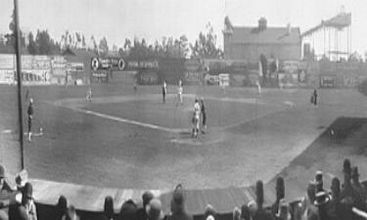 Robison Field 1892-1920 |  Sportsman’s Park* 1920-1966 |
 Busch Stadium II 1966-2005 | 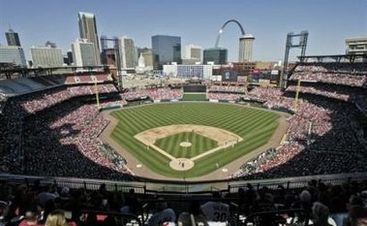 Busch Stadium III 2006-Present |
Classic Cardinals
 Roger Connor 1894-1897 |  Cy Young 1899-1900 | 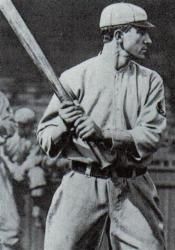 Ed Konetchy 1907-1913 | 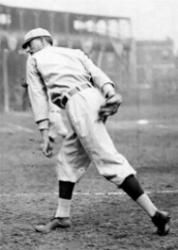 Slim Sallee 1908-1916 | 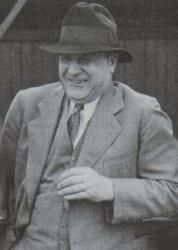 Branch Rickey President 1917-1942 | 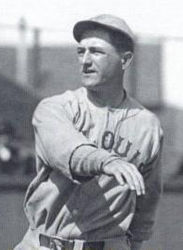 Milt Stock 1919-1923 |
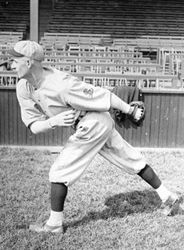 Bill Doak 1913-1924, 1929 |  Rogers Hornsby 1915-1926 1925 NL MVP |  Jack Smith 1915-1926 |  Bob O’Farrell 1925-1928, 1933, 1935 1926 NL MVP | 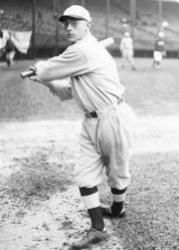 Specs Toporcer 1921-1929 | 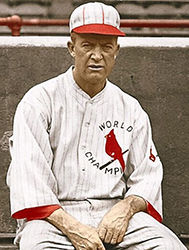 Grover Cleveland Alexander 1926-1929 |
 Taylor Douthit 1923-1931 |  Chick Hafey 1924-1931 |  Bill Sherdel 1918-1930, 1932 |  Ray Blades 1922-1928, 1930-1932 |  Jim Bottomley 1922-1932 1928 NL MVP | 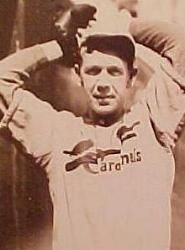 Bill Hallahan 1925-1936 |
 Ripper Collins 1931-1936 | 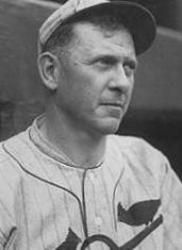 Jesse Haines 1920-1937 |  Frankie Frisch 1927-1937 1931 NL MVP |  Dizzy Dean 1930-1937 1934 NL MVP | 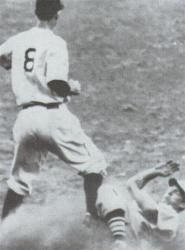 Joe Medwick slides hard into 3rd leading to 1934 Game 7 brawl |  Daffy Dean 1934-1939 |
 Joe Medwick 1932- 1940, 1947-1948 1937 MVP & Triple Crown |  Johnny Mize 1936-1941 |  Jimmy Brown 1937-1943 | 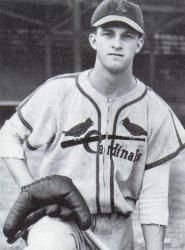 Stan Musial 1941 MLB Debut |  Pepper Martin 1928, 1930-1940, 1944 | 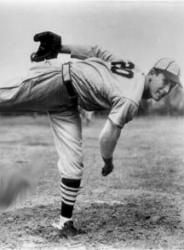 Mort Cooper 1938-1945 1942 NL MVP |
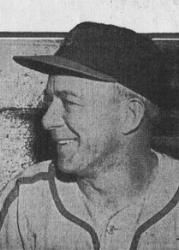 Billy Southworth MGR 1929, 1940-1945 |  Terry Moore 1935-1942, 1946-1948 | 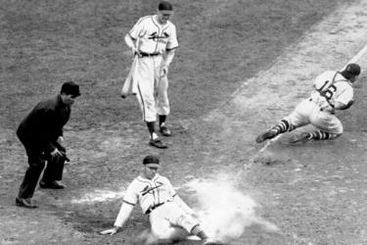 Enos “Country” Slaughter Scoring | 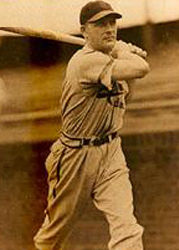 Whitey Kurkowski 1941-1949 |  Marty Marion 1940-1950 1944 NL MVP | |
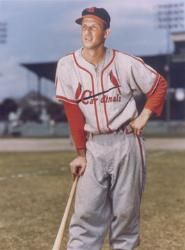 Stan “The Man” Musial 1943, 1946, & 1948 NL MVP | 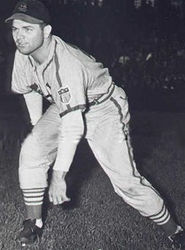 Max Lanier 1938-1946, 1949-1951 |  Howie Pollet 1941-1943, 1946-1951 | 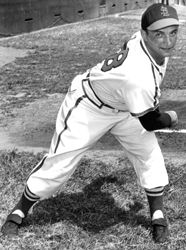 Ted Wilks 1944-1951 |  Harry Brecheen 1940, 1943-1952 |  Enos Slaughter 1938-1942, 1946-1953 |
 Al Brazle 1943, 1946-1954 |  Del Rice 1945-1955, 1960 | 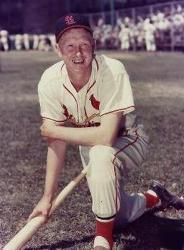 Red Schoendienst 1945-1956, 1961-1963 |  August A. Busch Owner 1953-1990 | 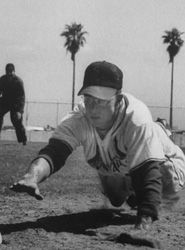 Bill Virdon 1955-1956 1955 Rookie of the Year |  Wally Moon 1954-1958 1954 Rookie of the Year |
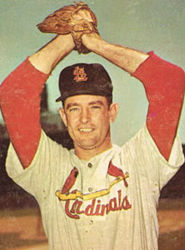 Larry Jackson 1955-1962 | 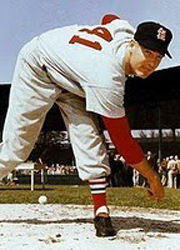 Lindy McDaniel 1955-1962 | 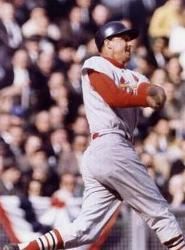 Stan Musial 1941-1944, 1946-1963 3,630 Career Hits | 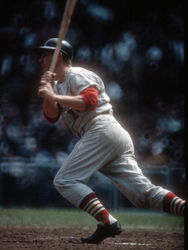 Ken Boyer 1955-1965 1964 NL MVP |  Bill White 1959-1965, 1969 | 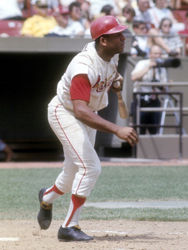 Orlando Cepeda 1966-1968 1967 NL MVP |
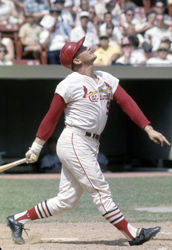 Roger Maris 1967-1968 |  Curt Flood 1958-1969 | 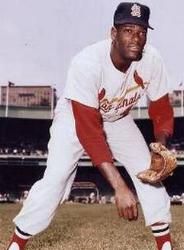 Bob Gibson 1968 & 1970 Cy Young 1968 NL MVP |  Bob Gibson 1964 & 1967 World Series MVP 1968:17 Strike Outs in Game 1 | 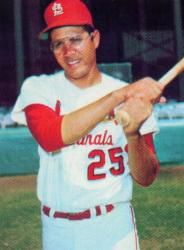 Julian Javier 1960-1971 | |
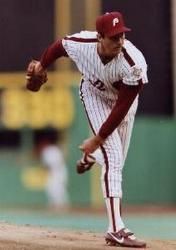 Steve Carlton 1972-1986 329 Wins 4,136 K's |  Tim McCarver 1959-1969, 1973-1974 |  Joe Torre 1969-1974 1971 NL MVP | 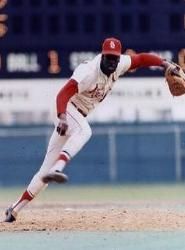 Bob Gibson 1959-1975 | 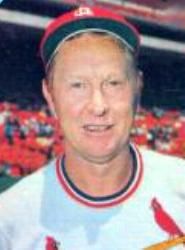 Red Schoendienst MGR 1965-1976, 1980, 1990 | 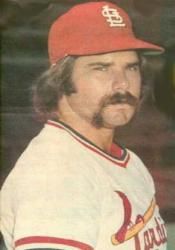 Al Hrabosky 1970-1977 |
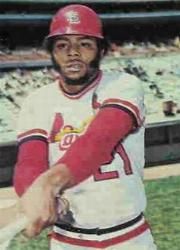 Bake McBride 1973-1977 1974 Rookie of the Year |  Lou Brock 1964-1979 938 Career Stolen Bases |  Ted Simmons 1968-1980 | 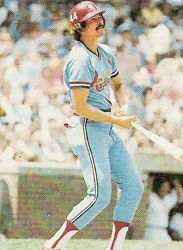 Ken Reitz 1972-1980 | 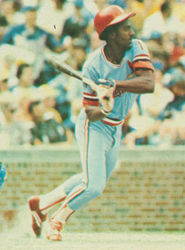 Garry Templeton 1976-1981 |  Keith Hernandez 1974-1983 1979 NL MVP |
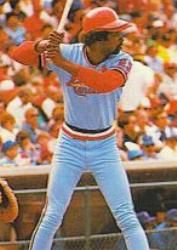 George Hendrick 1978-1984 |  Bruce Sutter 1981-1984 | 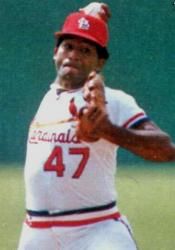 Joaquin Andujar 1981-1985 | 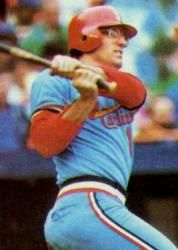 Darrell Porter 1981-1985 1982 NLCS & WS MVP |  Lonnie Smith 1982-1985 |  Jack Clark 1985-1987 |
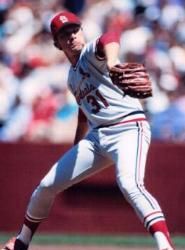 Bob Forsch 1974-1988 | 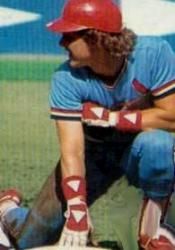 Tommy Herr 1979-1988 | 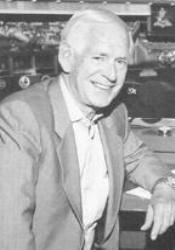 Jack Buck 1954-2001 | 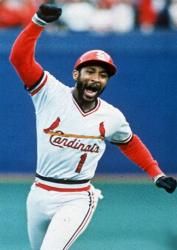 Ozzie Smith 1985 NLCS MVP | 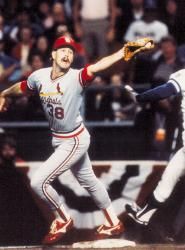 Safe?: Don Deckinger’s controversial 19 | 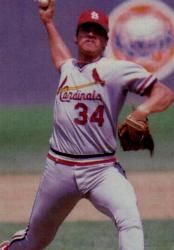 Danny Cox 1983-1988 |
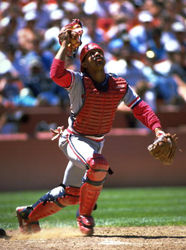 Tony Pena 1987-1989 |  Whitey Herzog MGR 1980, 1981-1990 |  Willie McGee 1982-1990, 1996-1998 1985 NL MVP | 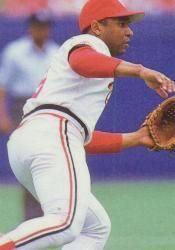 Terry Pendleton 1984-1990 | 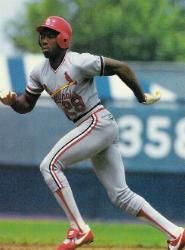 Vince Coleman 1985-1990 1985 Rookie of the Year | 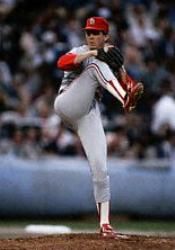 John Tudor 1985-1988, 1990 |
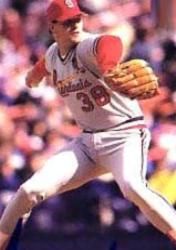 Todd Worrell 1985-1992 1986 Rookie of the Year |  Joe Magrane 1987-1993 | 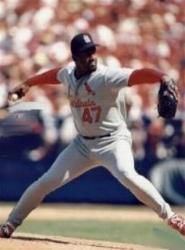 Lee Smith 1990-1993 | 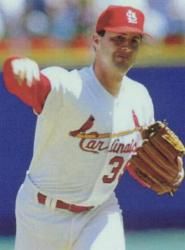 Bob Tewksbury 1989-1994 | 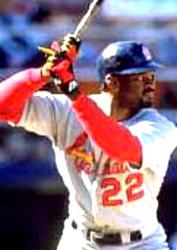 Mark Whiten 1993-1994 |  Jose Oquendo 1986-1995 |
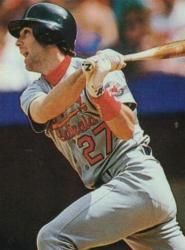 Todd Zeile 1989-1995 |  “The Wizard” 1982-1996 Ozzie Smith | 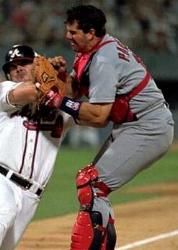 Tom Pagnozzi 1987-1998 | 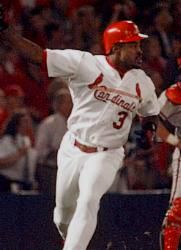 Brian Jordan 1992-1998 |  John Mabry 1994-1998, 2001, 2005 | 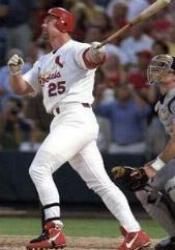 Mark McGwire 1997-2001 583 Career HR |
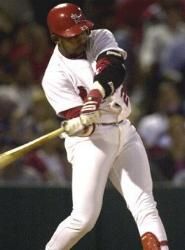 Fernando Tatis 1998- 2000 | 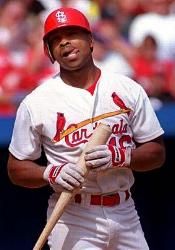 Ray Lankford 1990-2001, 2004 | 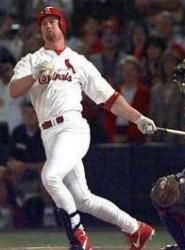 Mark McGwire 1998 70 Home Runs |  Albert Pujols 2001-2011 | 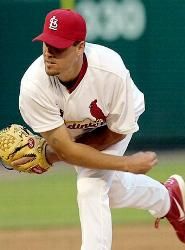 Darryl Kile 2000-2002 |  J.D. Drew 1998-2003 |
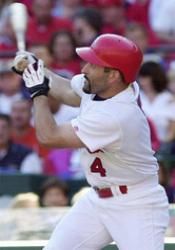 Fernando Viña 1999-2003 | 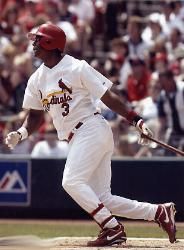 Edgar Renteria 1999-2004 |  Mike Matheny 2000-2004 | 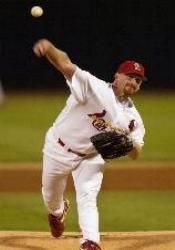 Woody Williams 2001-2004 | 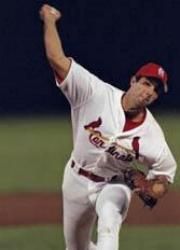 Matt Morris 1997-2005 | 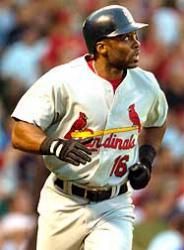 Reggie Sanders 2004-2005 |
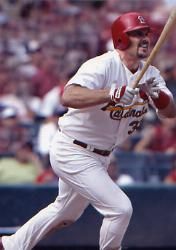 Larry Walker 2004-2005 | 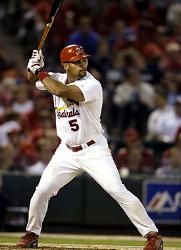 Albert Pujols 2004 NLCS MVP 2005, 2008, 2009 NL MVP |  Jeff Suppan 2004-2006, 2010 2006 NLCS MVP | 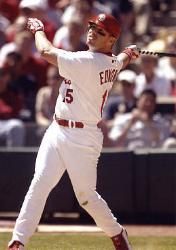 Jim Edmonds 2000-2007 | 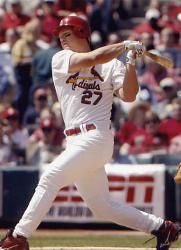 Scott Rolen 2002-2007 | 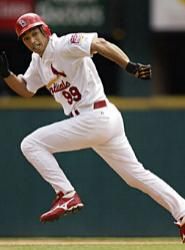 So Taguchi 2002-2007 |
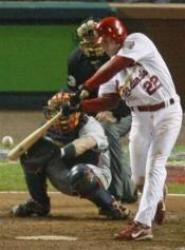 David Eckstein 2005-2007 2006 World Series MVP | 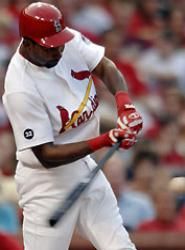 Juan Encarnacion 2006-2007 | 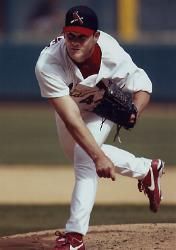 Jason Isringhausen 2002-2008 | 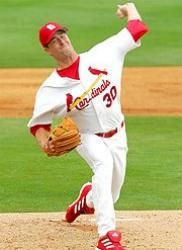 Mark Mulder 2005-2008 | 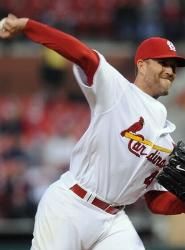 Braden Looper 2006-2008 | 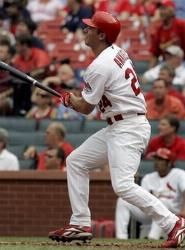 Rick Ankiel 1999-01, 2004, 2007-09 |
 Chris Duncan 2005-2009 |  Joel Pineiro 2007-2009 | 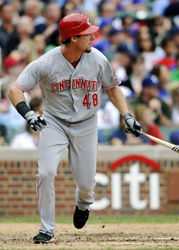 Ryan Ludwick 2012-2014 |  Tony LaRussa MGR 1996-2011 |  Albert Pujols 2001-2011 |  Ryan Franklin 2007-2011 |
 Colby Rasmus 2009-2011 | 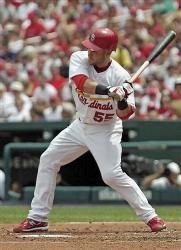 Skip Schumaker 2005-2012 | 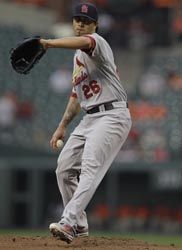 Kyle Lohse 2008-2012 | 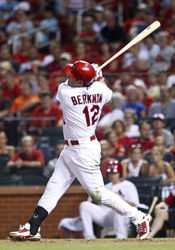 Lance Berkman 2011-2012 | 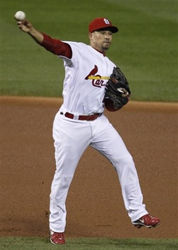 Rafael Furcal 2011-2012 | 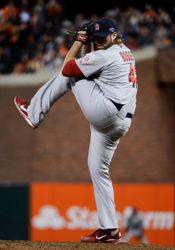 Mitchell Boggs 2008-2013 |
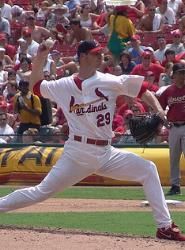 Chris Carpenter 2004-2013 2005 Cy Young |  David Freese 2009-2013 2011 NLCS & WS MVP | 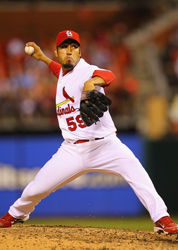 Fernando Salas 2010-2013 | 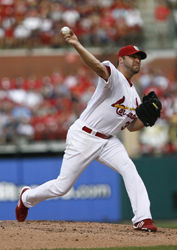 Jake Westbrook 2010-2013 |  Carlos Beltran 2012-2013 | 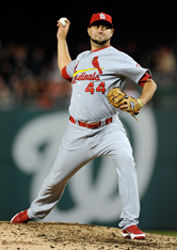 Carlos Beltran 2012-2013 |
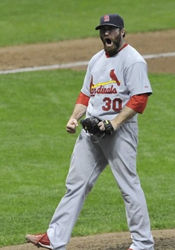 Jason Motte 2008-2014 | 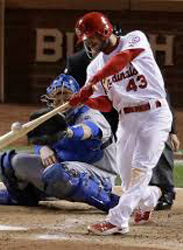 Shane Robinson 2009, 2011-2014 | 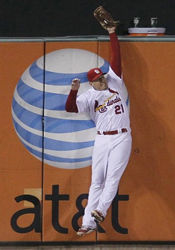 Allen Craig 2010-2014 |  Daniel Descalso 2010-2014 | 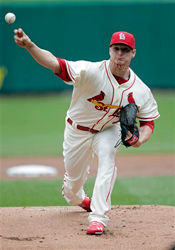 Shelby Miller 2012-2014 | 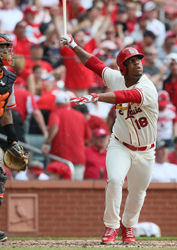 Oscar Taveras 2014 |
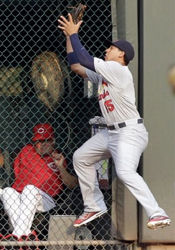 Jon Jay 2010-2015 | 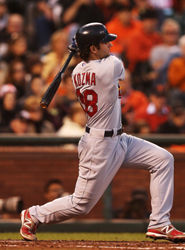 Pete Kozma 2011-2015 | 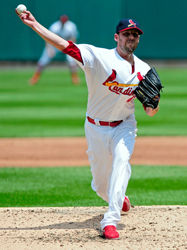 John Lackey 2014-2015 |  Jason Heyward 2015-2015 | 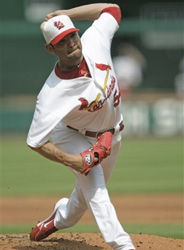 Jaime Garcia 2008, 2010-2016 | 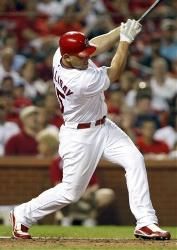 Matt Holliday 2009-2016 |
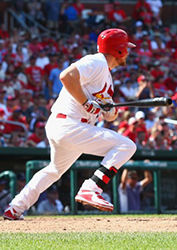 Brandon Moss 2015-2016 |  Lance Lynn 2011-2017 | 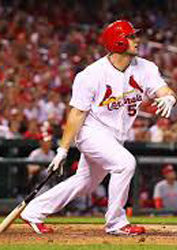 Matt Adams 2012-2017 |  Trevor Rosenthal 2012-2017 |  Randal Grichuk 2014-2017 | 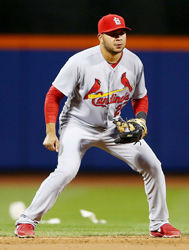 Jhonny Peralta 2014-2017 |
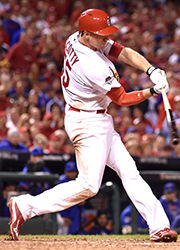 Stephen Piscotty 2015-2017 | 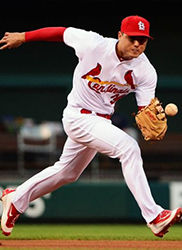 Aledmys Diaz 2016-2017 | 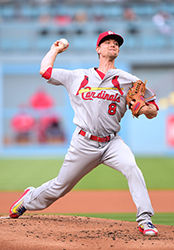 Mike Leake 2016-2017 | 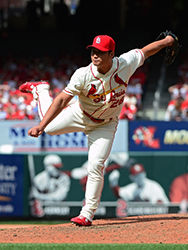 Seung-Hwan Oh 2016-2017 |  Tommy Pham 2014-2018 |  Michael Wacha 2013-2019 2013 NLCS MVP |
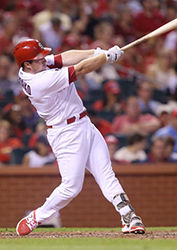 Jedd Gyorko 2016-2019 | 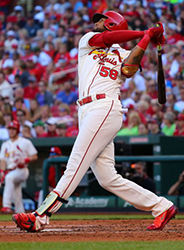 Jose Martinez 2013-2019 |  Marcell Ozuna 2018-2019 | 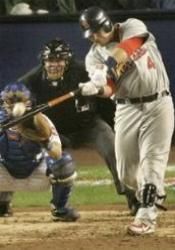 Yadier Molina 2004-Present | 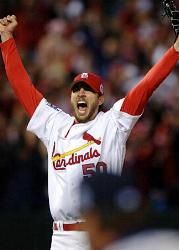 Adam Wainwright 2005-Present | 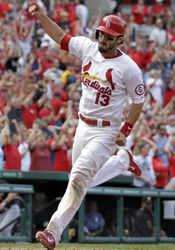 Matt Carpenter 2011-Present |
